______________________________________________________________________________
Harriet & I walked up quite a few streets from Hotel Alpinea and finally found this small museum. The museum was a very rustic building built with wooden logs and hand-adzed timbers and a split wooden shingle roof. Every thing in the museum is handcrafted from the 17th -19th century. It had a very personal quality to everything on display.
Outside the Museum
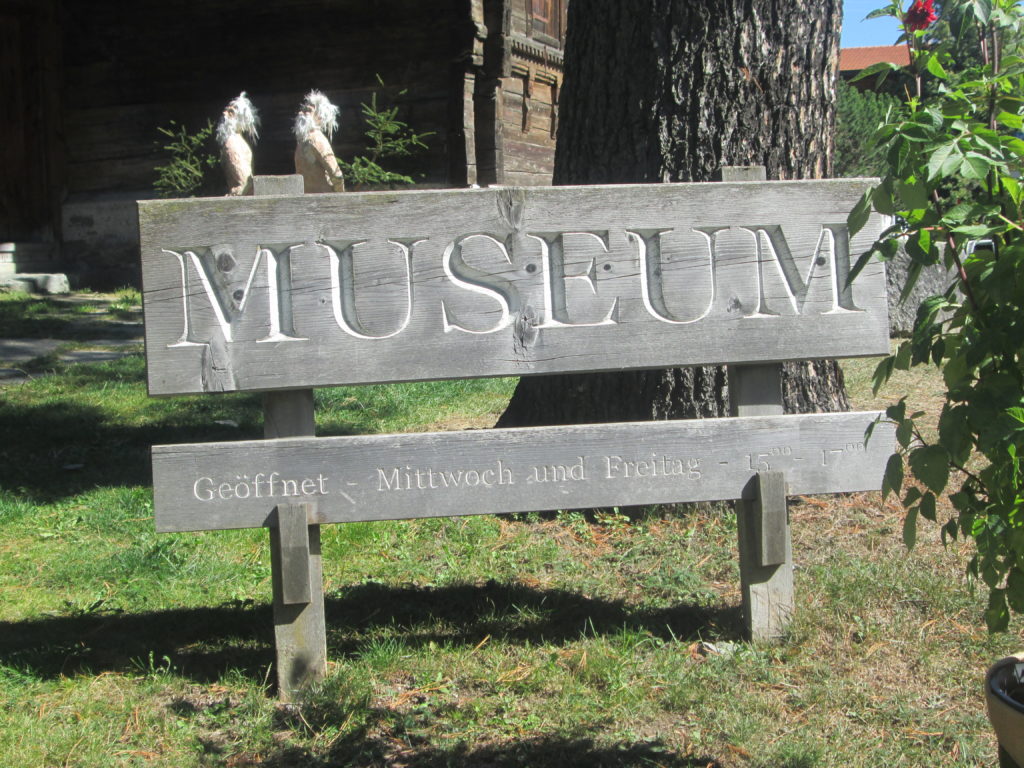
A big wooden sign marking the entry to the museum.
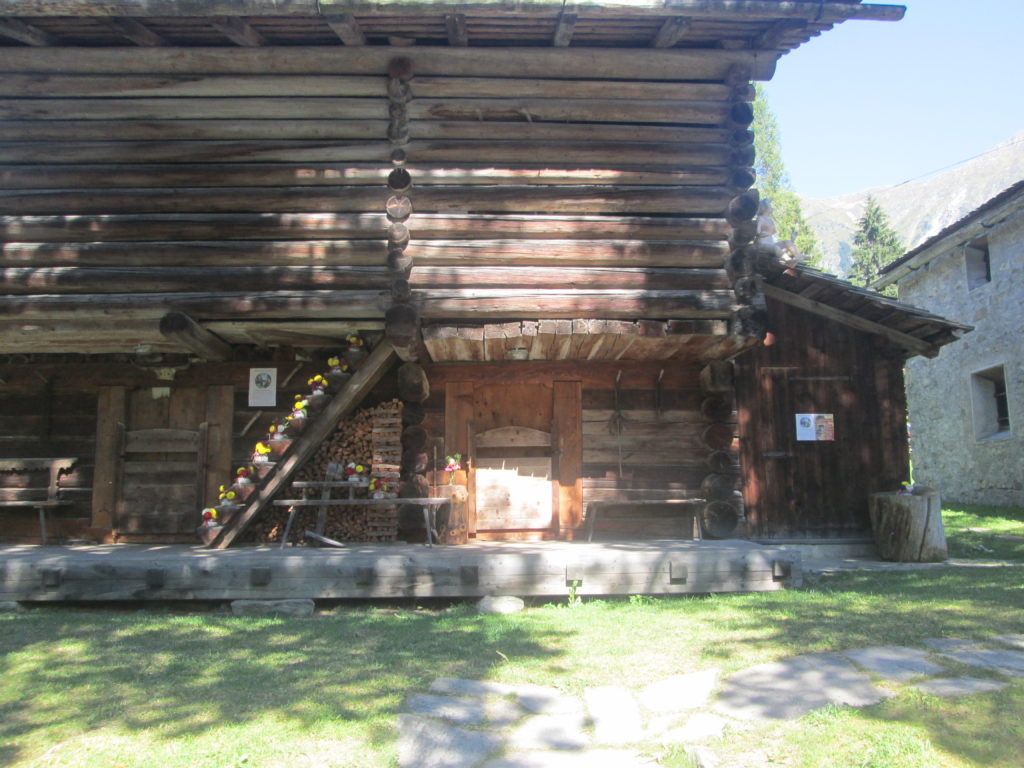
As was said above: The museum is a very rustic building built with wooden logs and hand-adzed timbers. Every thing in the museum is handcrafted from the 17th -19th century. It had a very personal quality to everything on display. Harriet and I love handmade things rather than machine built things. This is why we went to find the museum up many side streets.
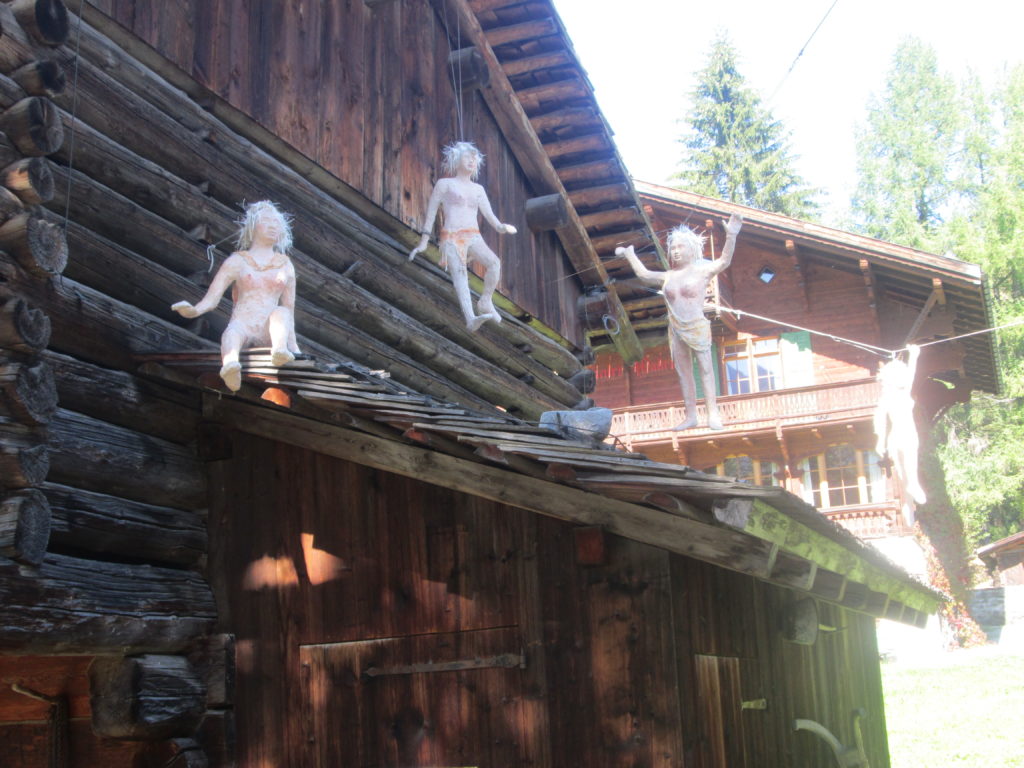
Whimsical humanoid figures adorn the outside of the museum entry.
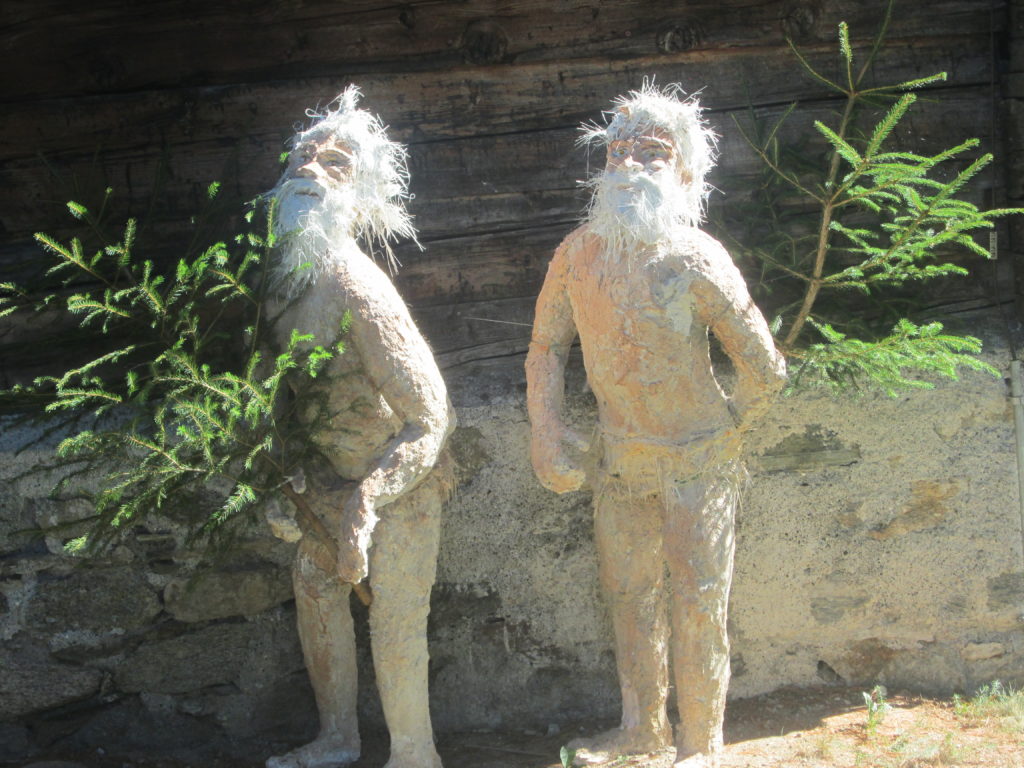
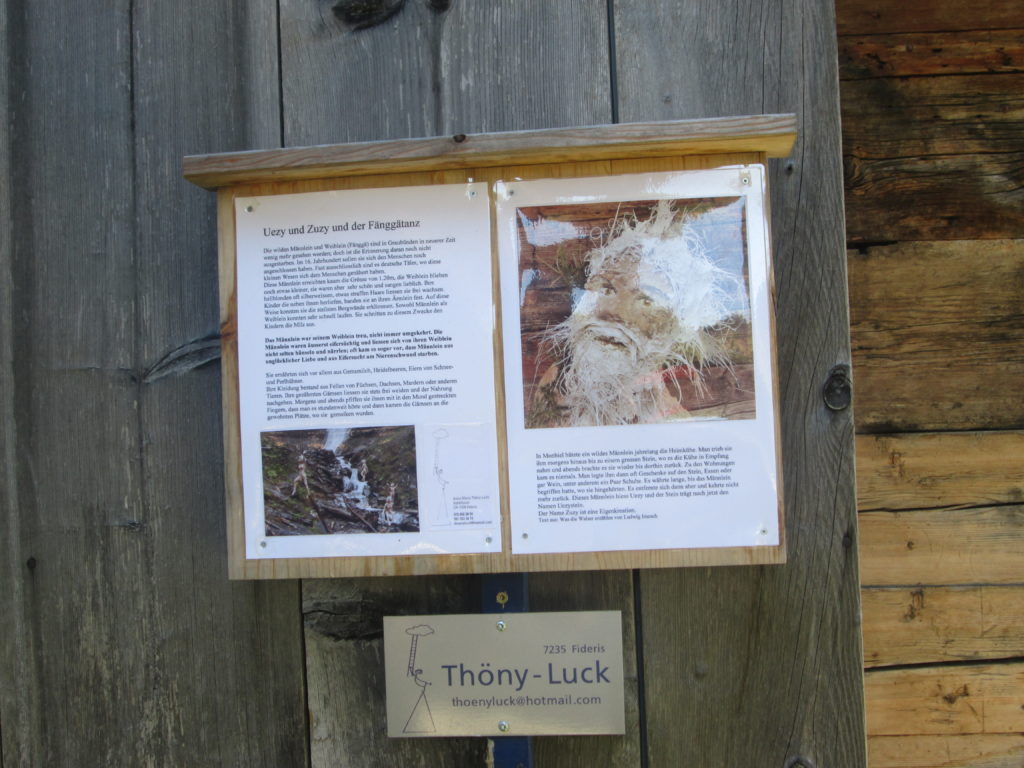
The sign on the artist was in the Switz language so I couldn’t read it.
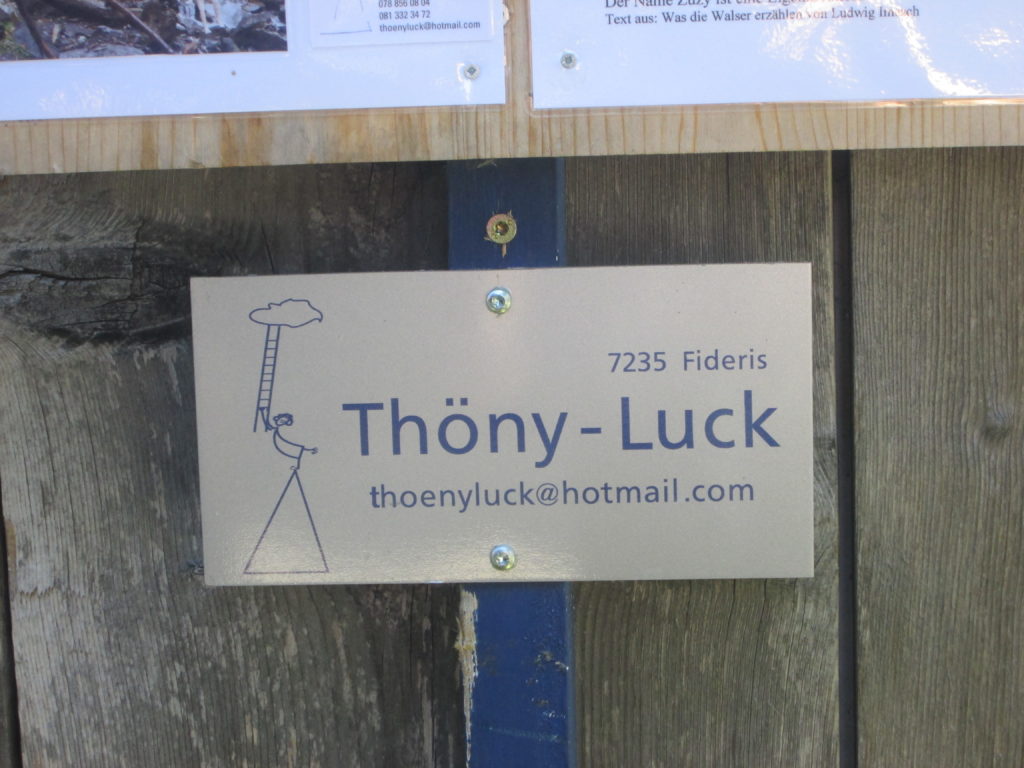
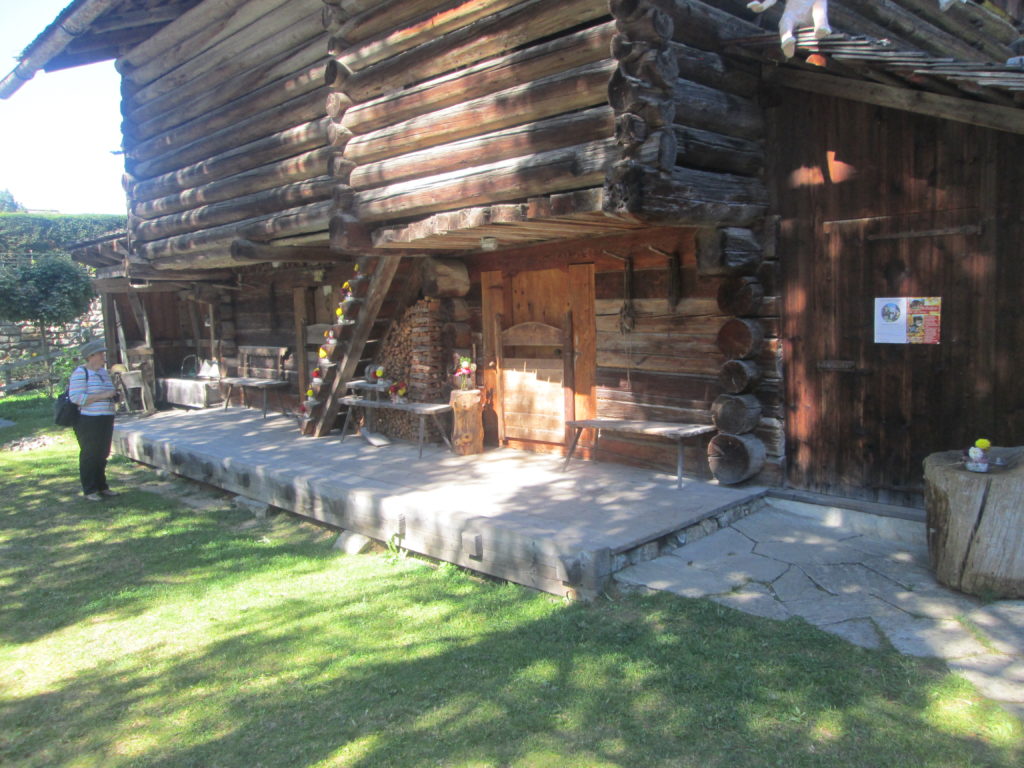
Another view of the museum as a very rustic building built with wooden logs and hand-adzed timbers. Entry into the museum is via a set of hand-adzed timber steps that goes from the Ground floor to Floor 1. See the photograph below.
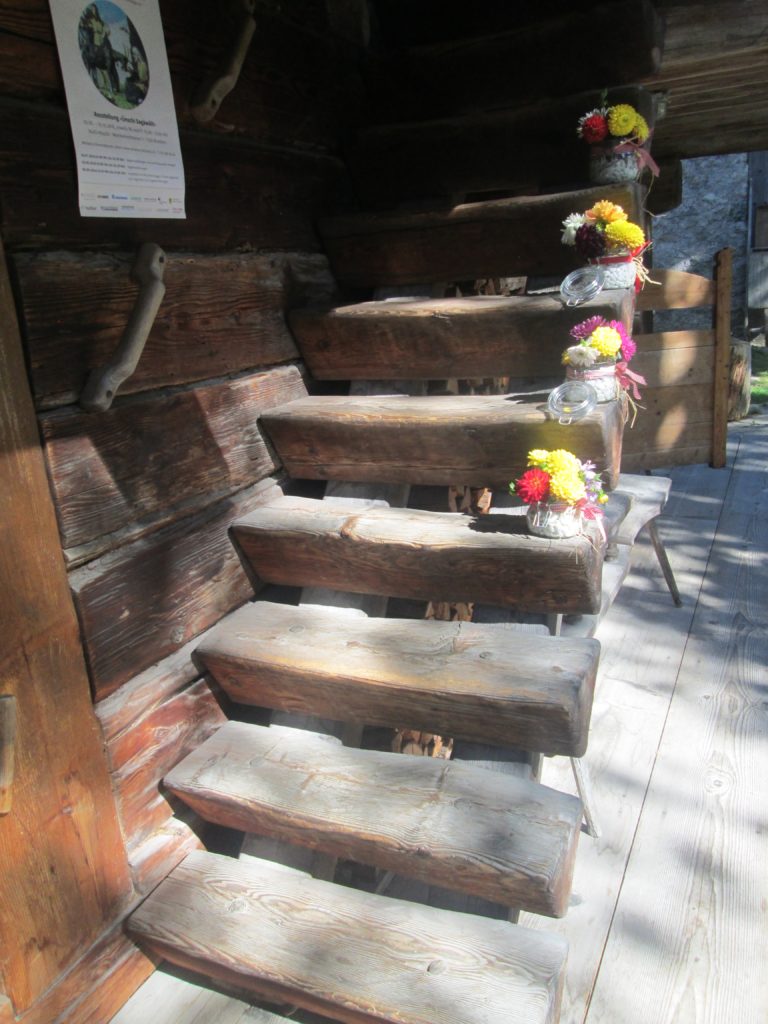
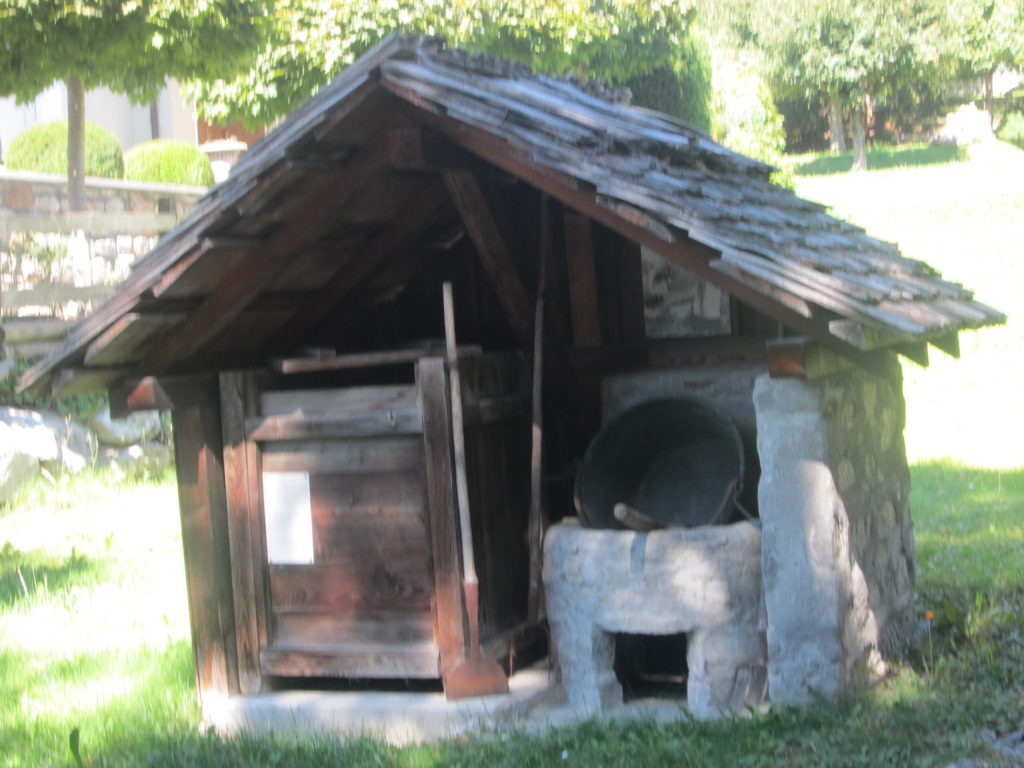
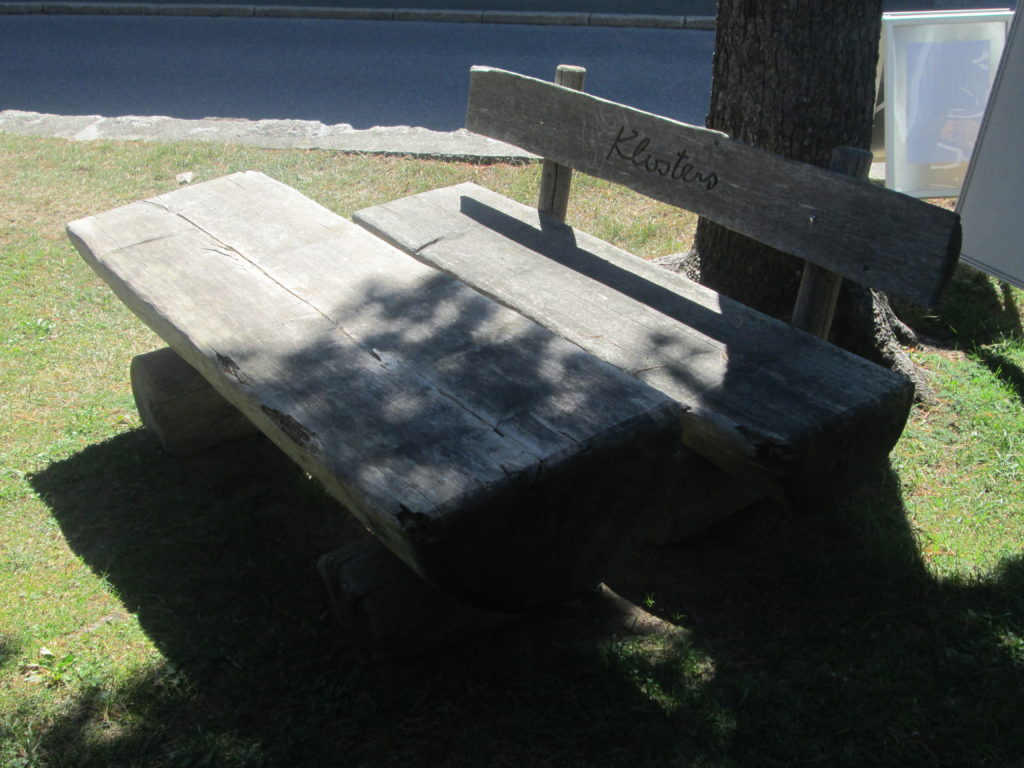
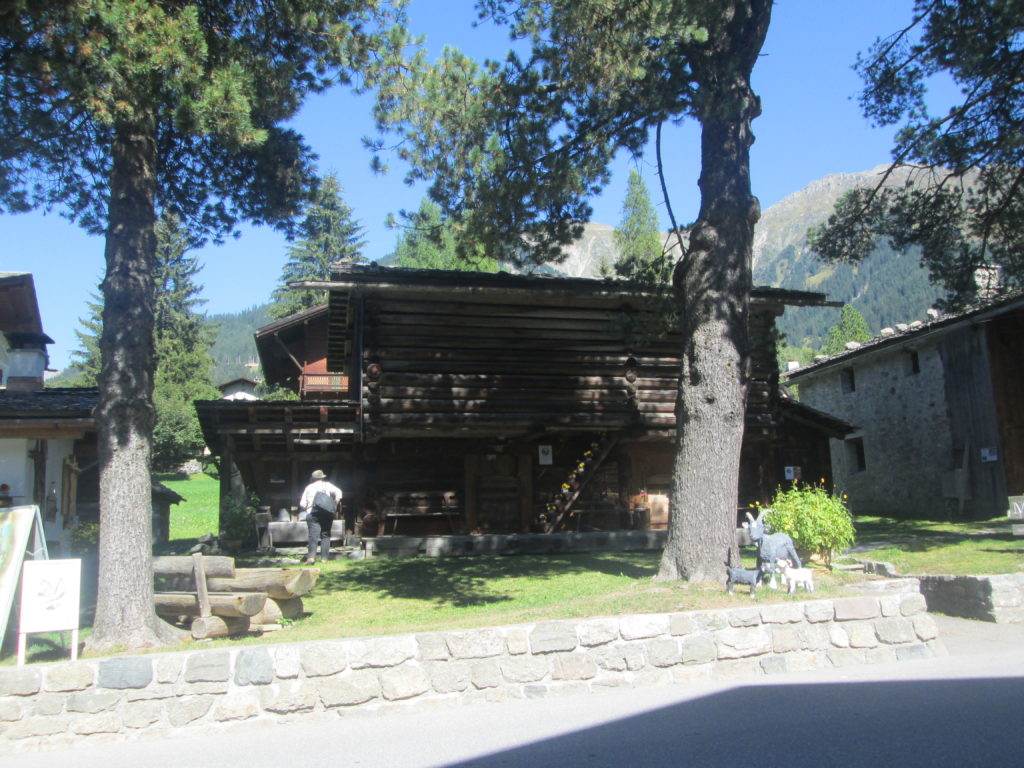
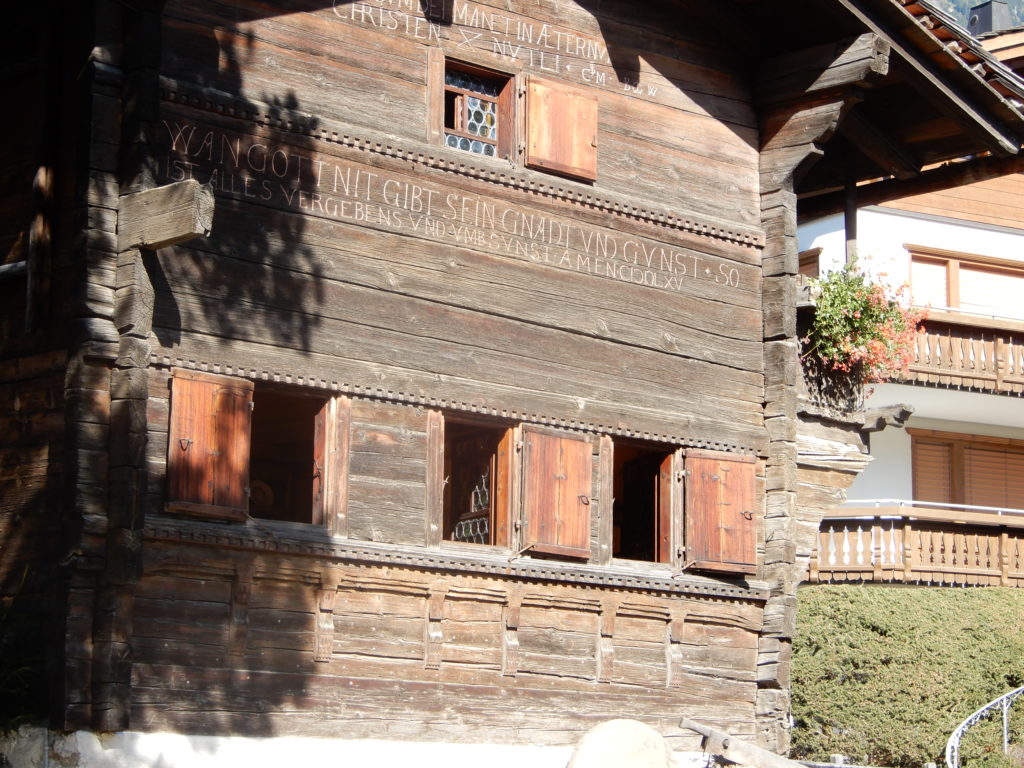
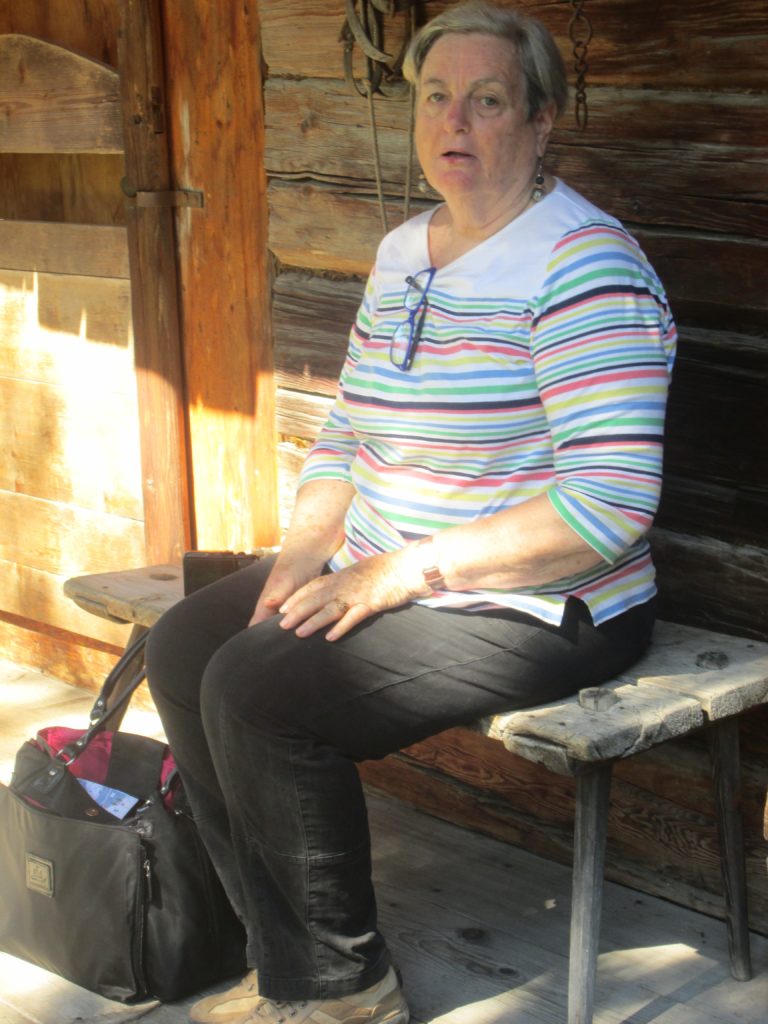
_________________________________________________________________________________________________
Inside the Museum
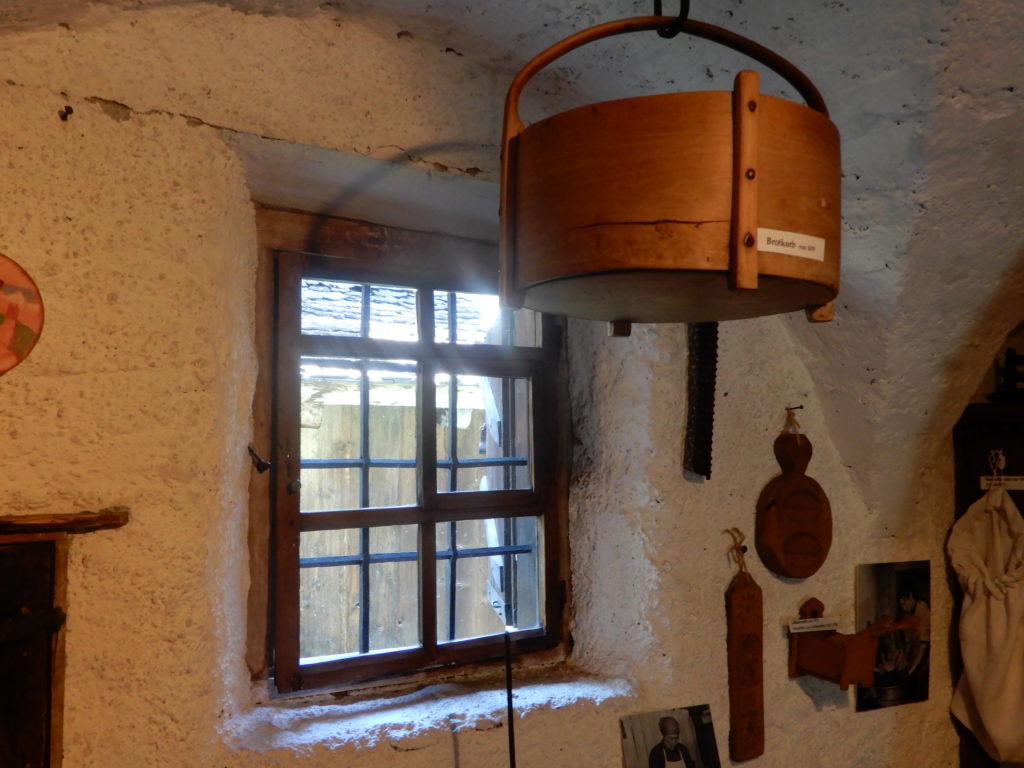
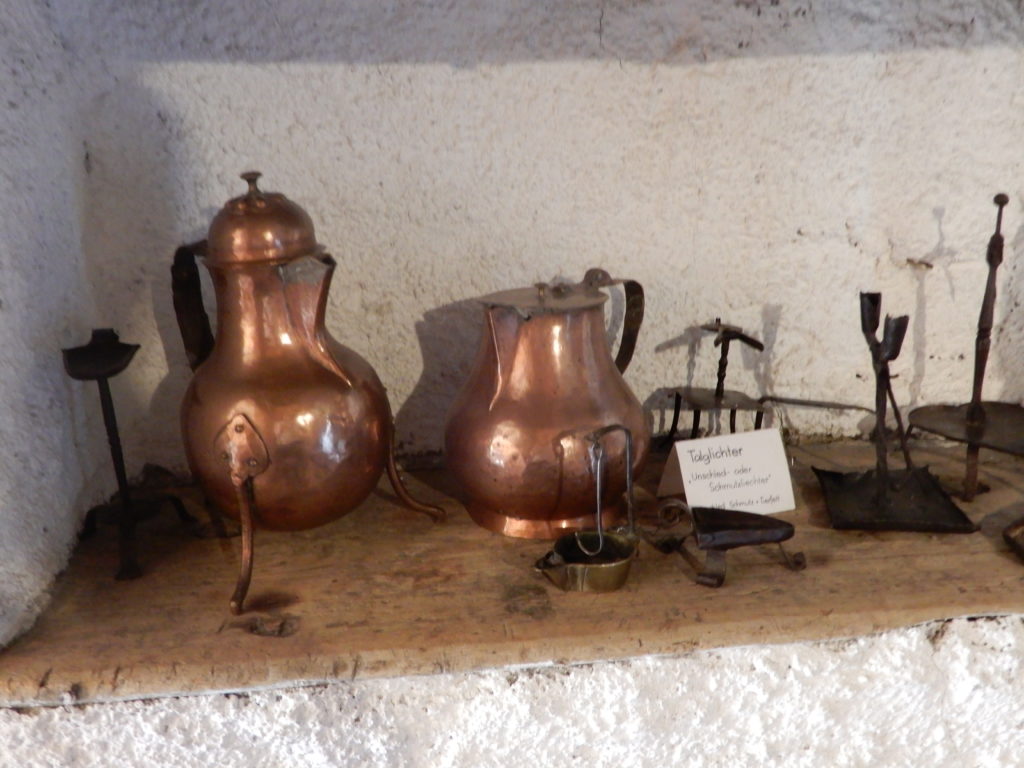
Copper kettles.
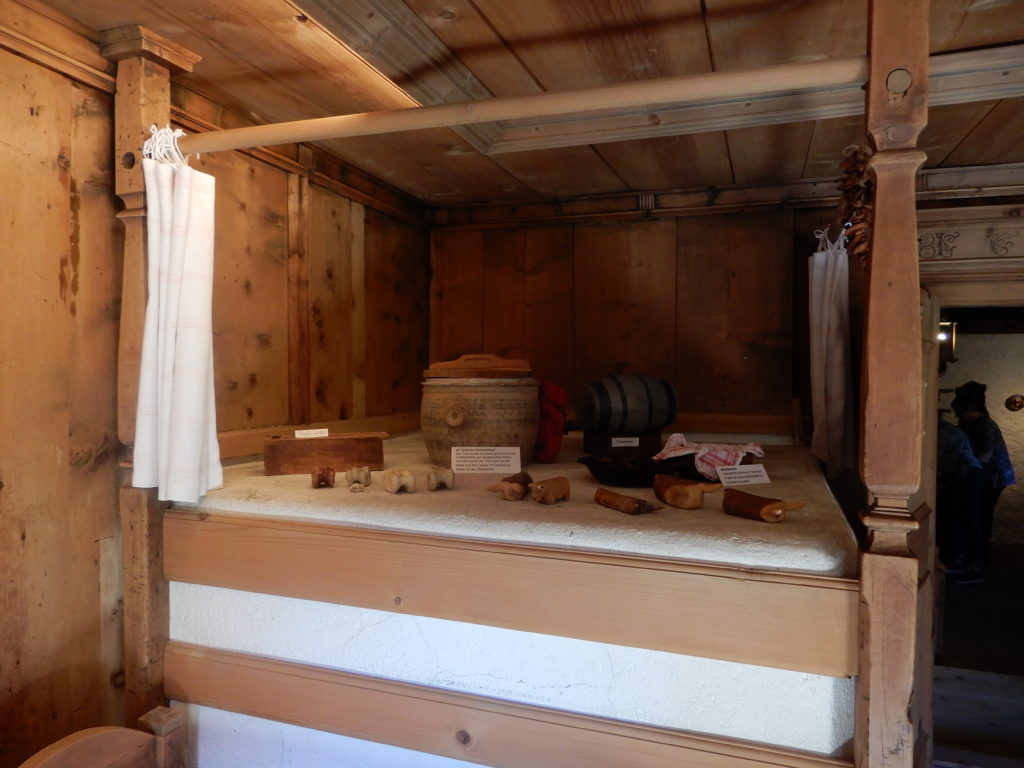
A bed used by Klosters people in the 19th century. The bed is now covered with small historical items.
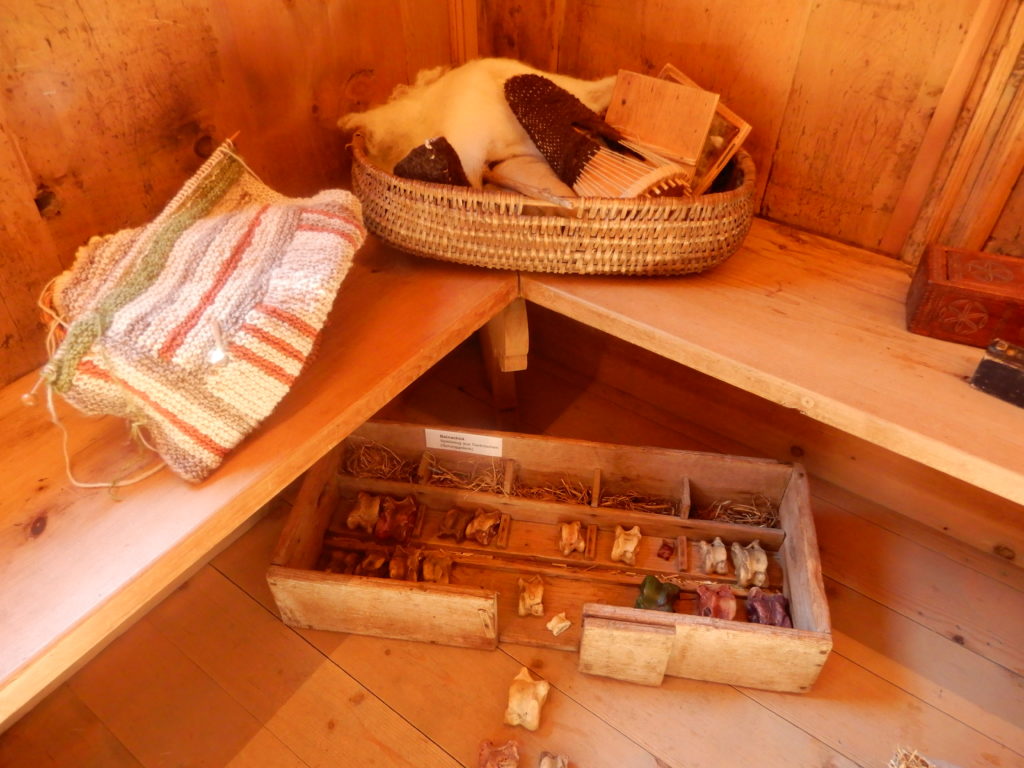

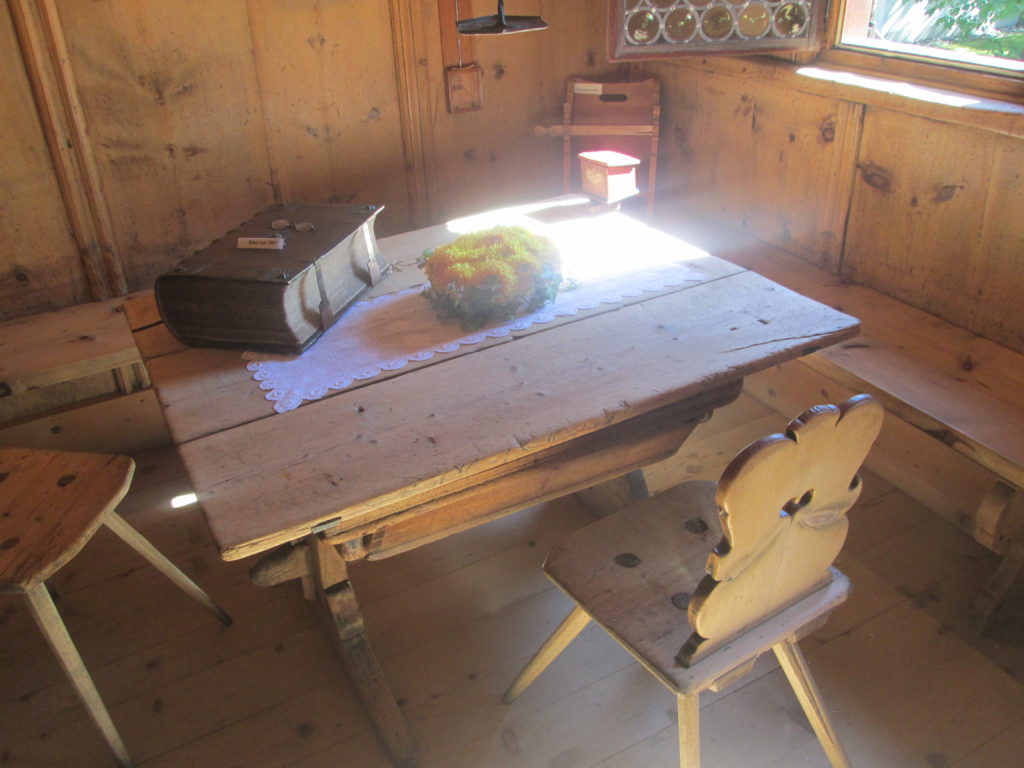
A big Bible from 1667 on a table for reading.
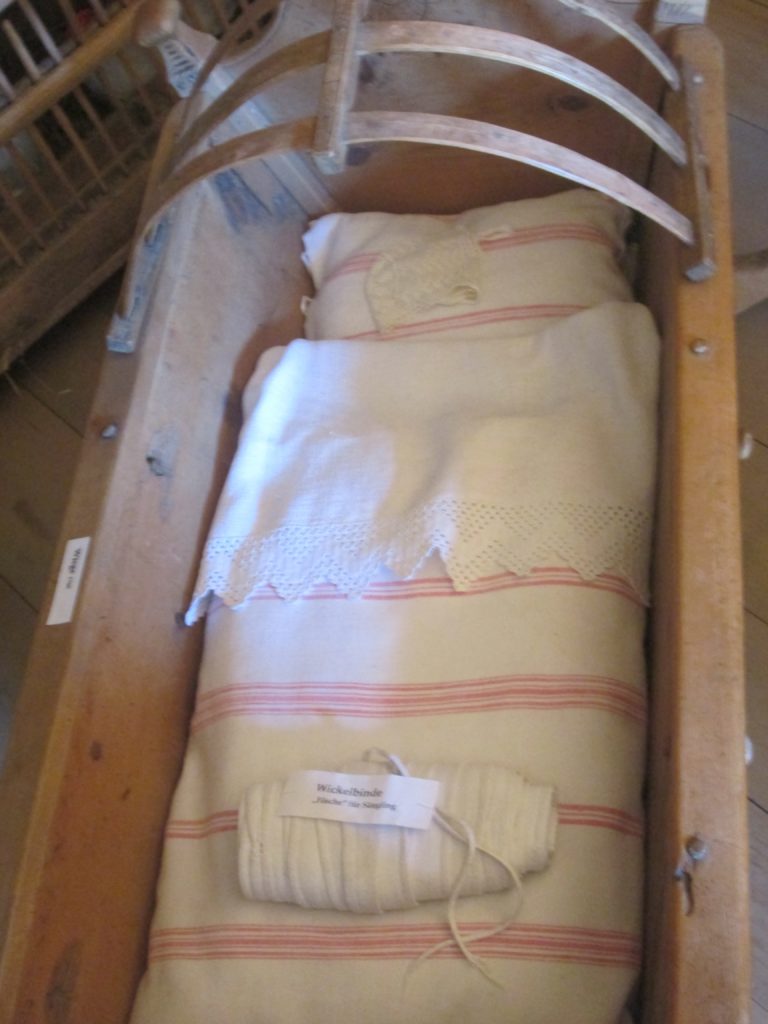
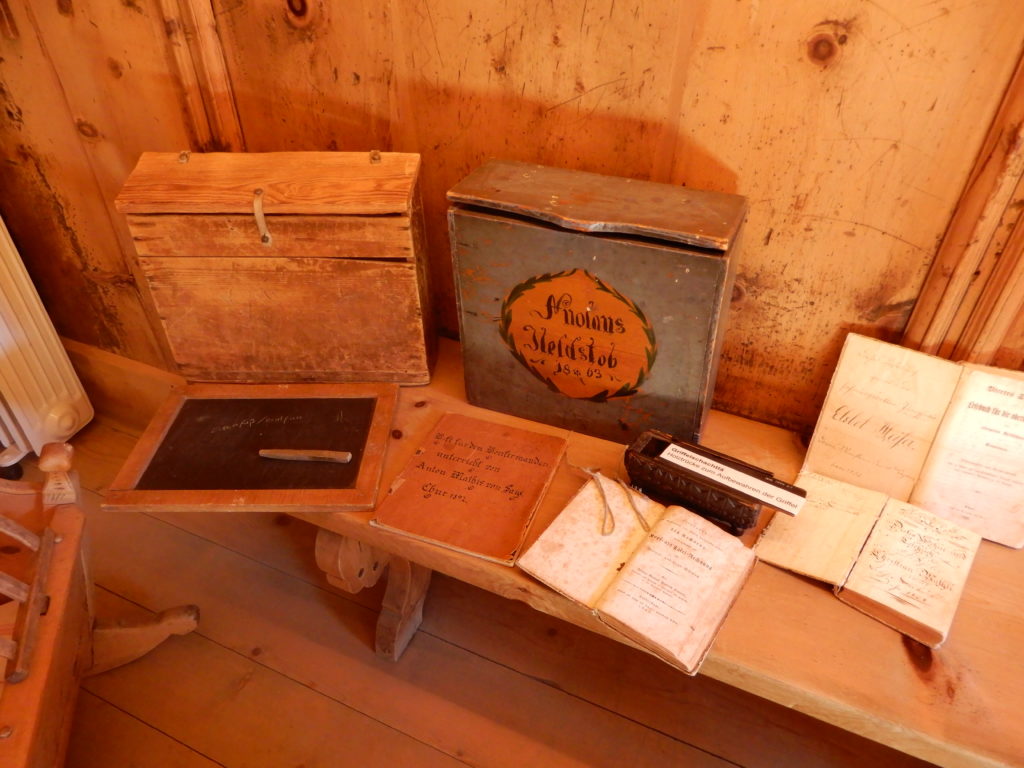
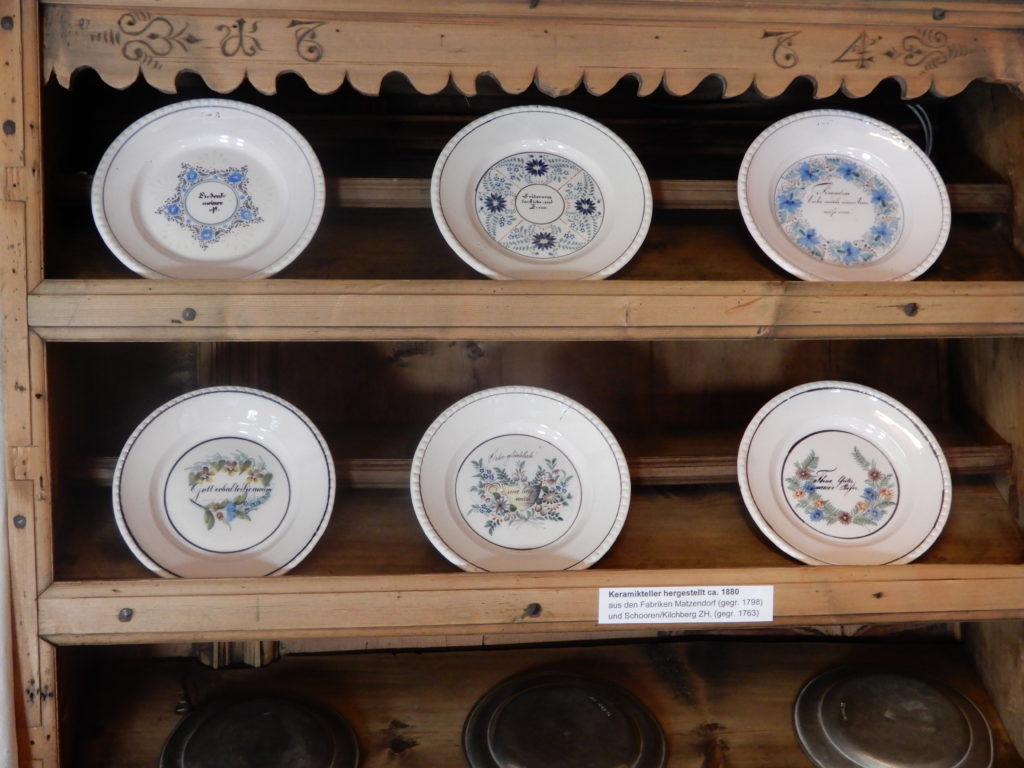
Plates used around 1880.
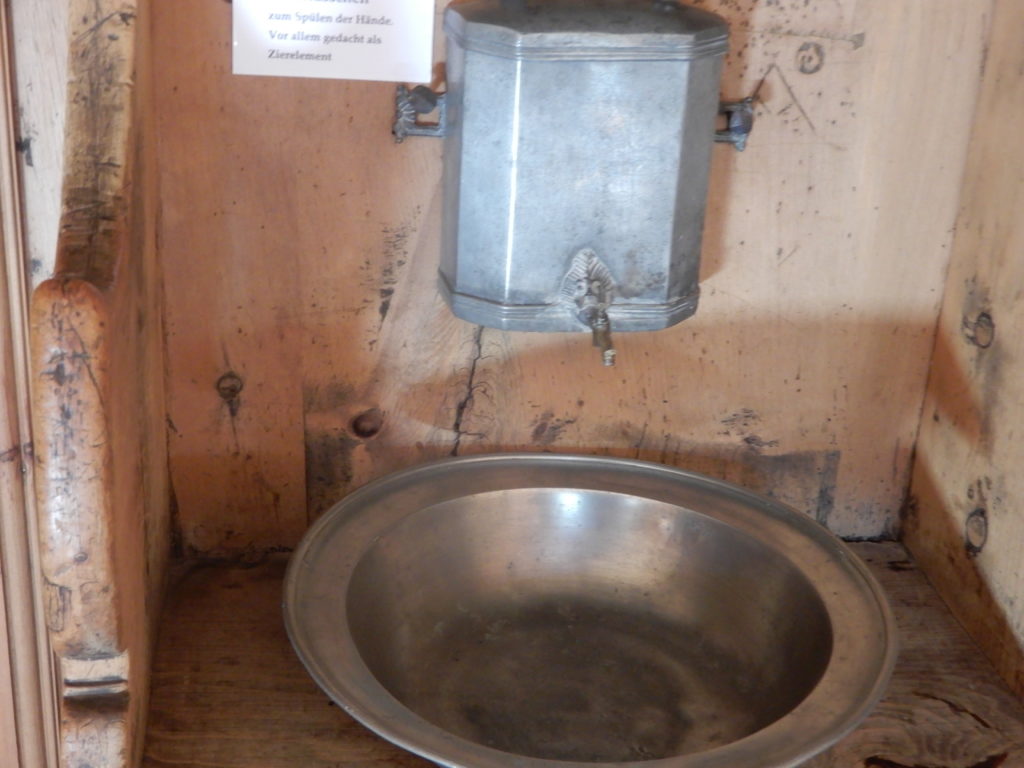
A small water tank and tap ….. the water flowed into a metal basin. It is not the same as running water we have in our houses in the 21st century.
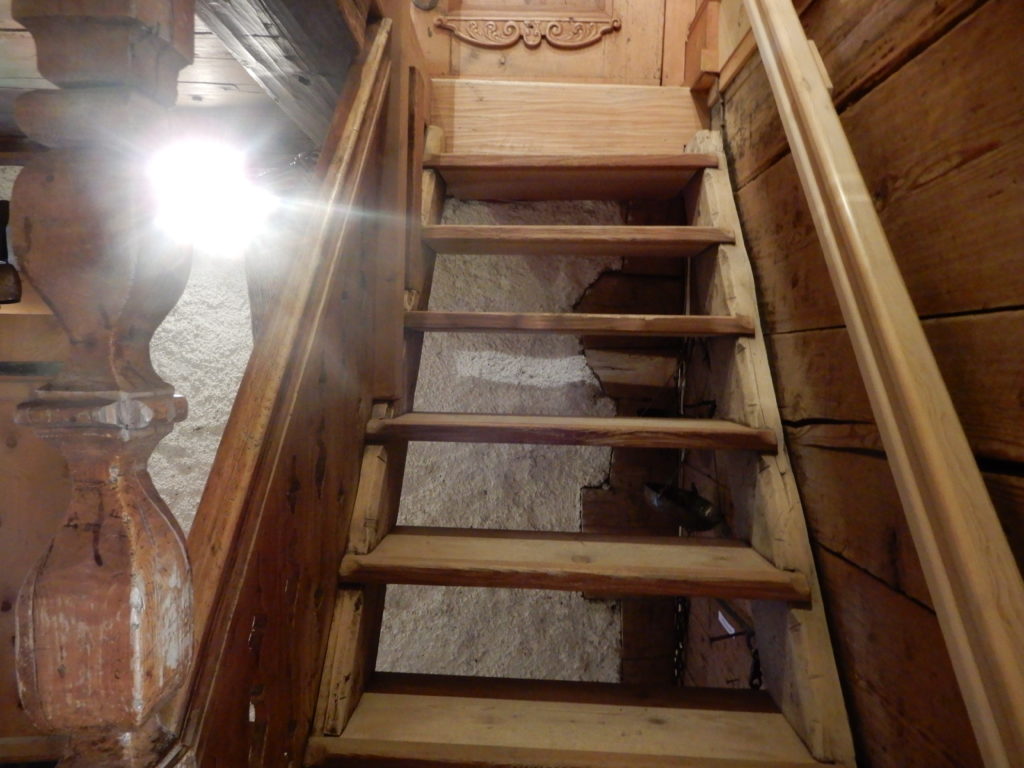
A small set of steps leads up to a 3rd floor in the museum.
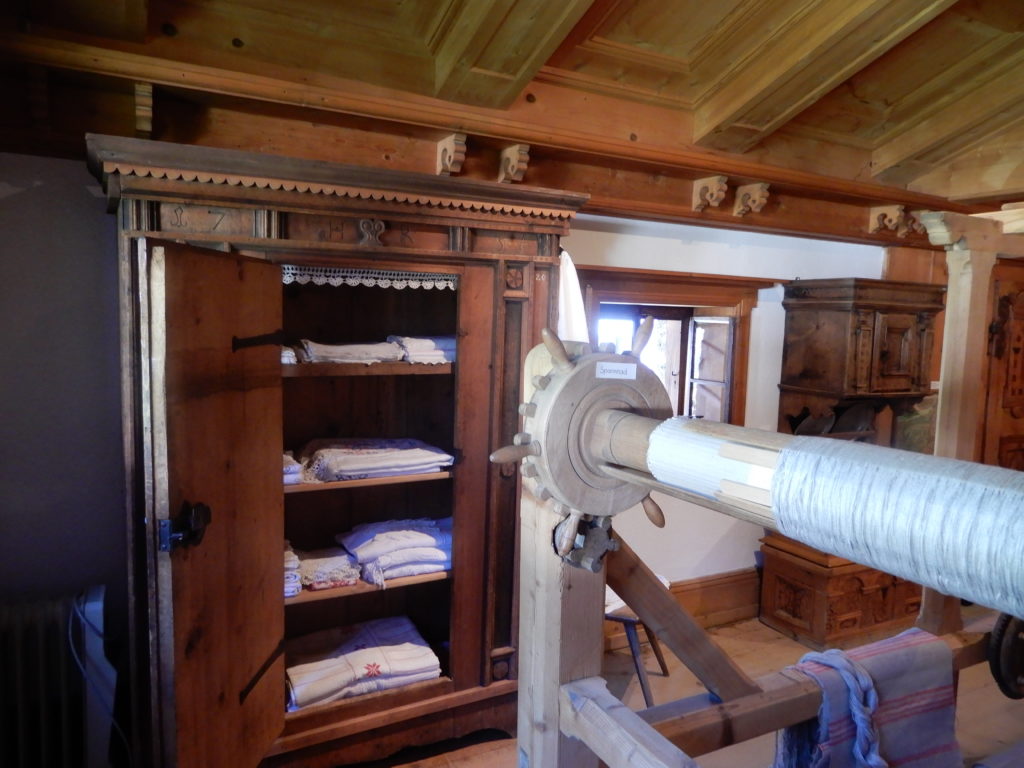
Up on the third floor was a spinning wheel for making cloth from which clothes could be made by hand. See the samples of clothes in the adjacent cupboard. It is a bit different to clothes being made by machines in the 21st century.
Look at these websites:
Environmental Impact of clothing today
What Happens When Fashion Becomes Fast, Disposable And Cheap?
Attention, Shoppers
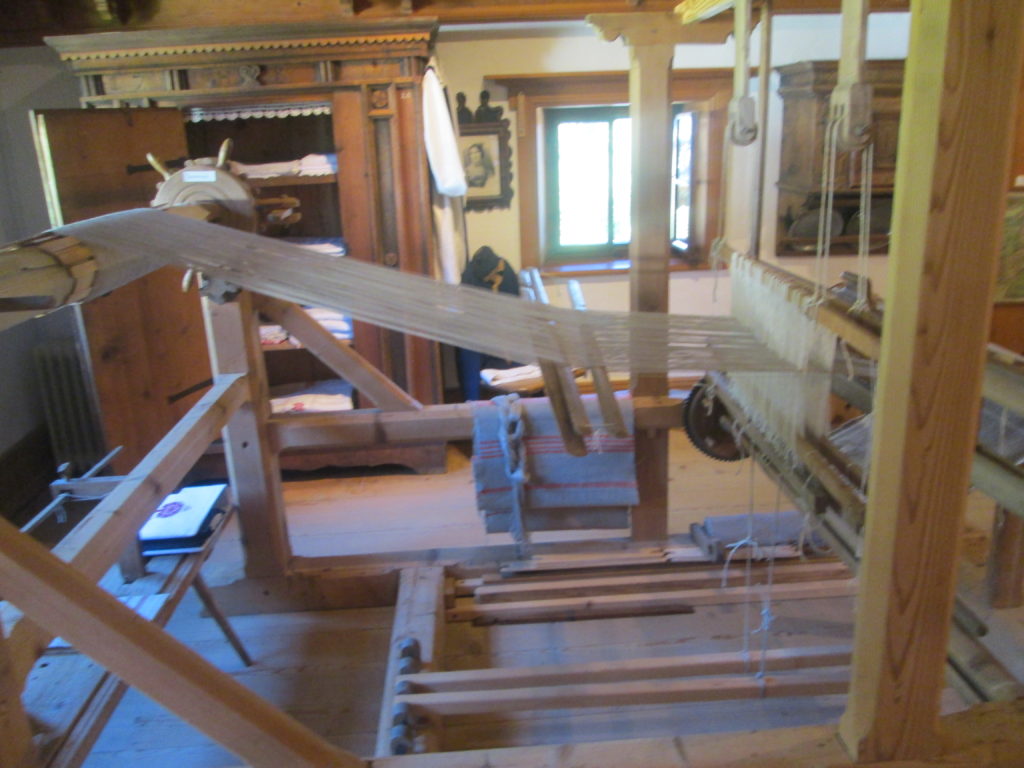
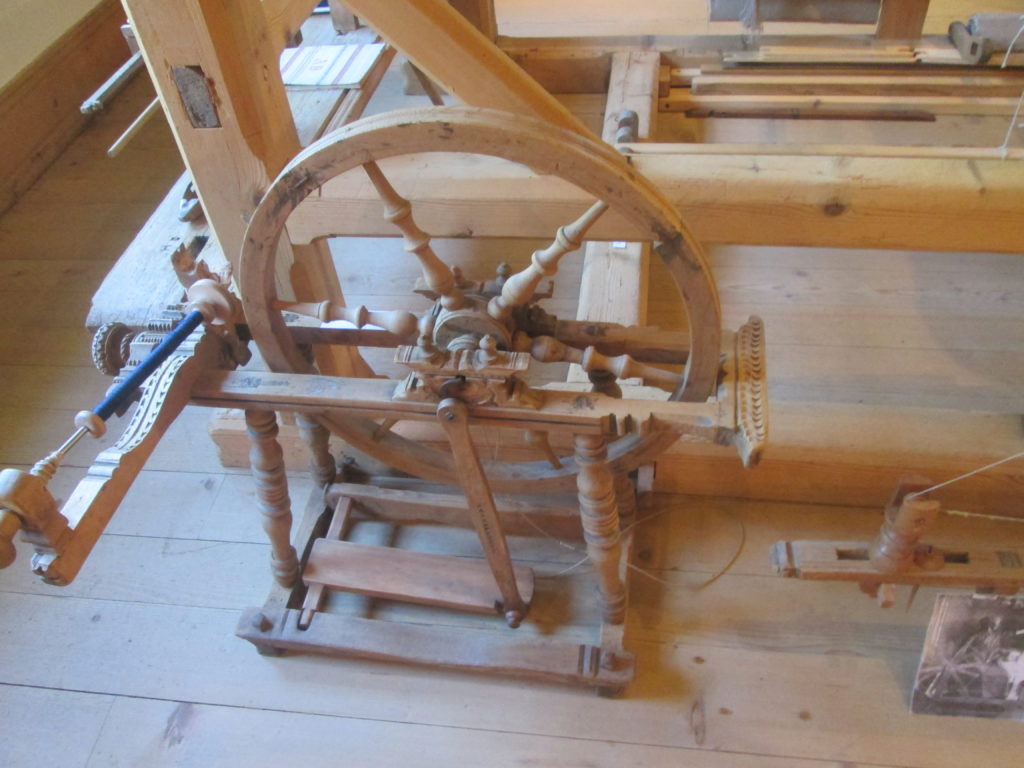
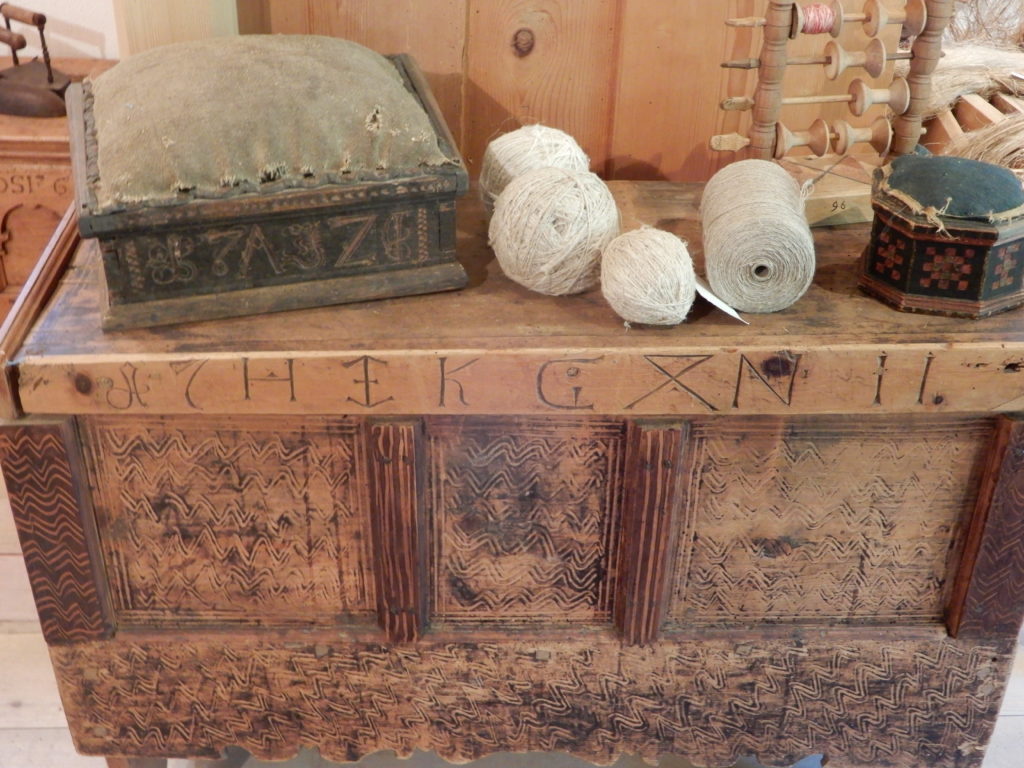
A cupboard on which is shelf for balls and rolls of wool for stitching clothes.
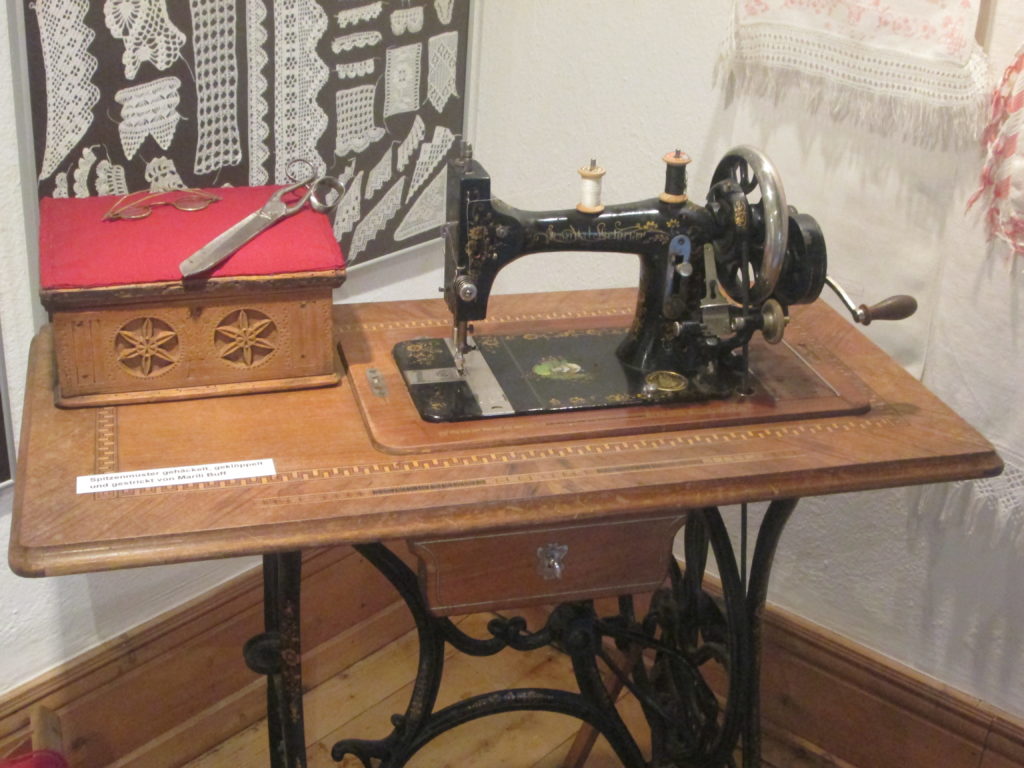
A sowing machine used for making clothes by hand. I well remember my mother Norma Aitken had one of these machines in the 1960’s when we lived on a banana plantation at Wilsons Creek, Mullumbimby, the Northern Rivers area of New South Wales in Australia.
See the post on my Personal Experiences website:
Wilsons Creek where Ken Aitken Grew Up in the 1950’s and 1960’s ….
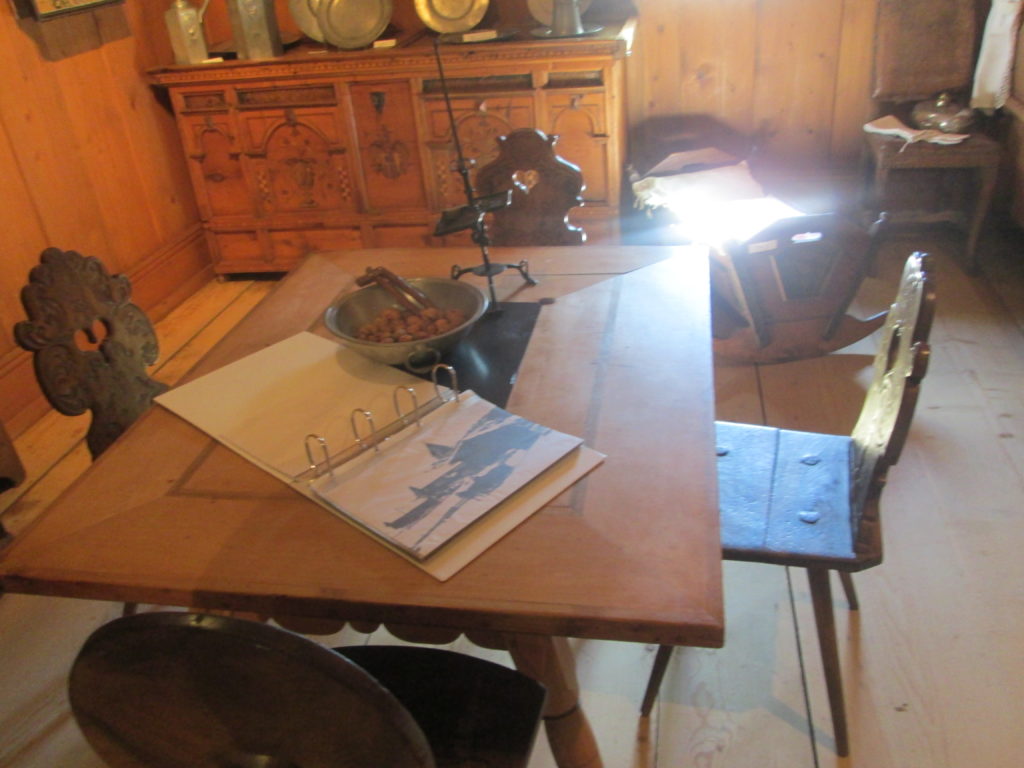
A table and chair for general reading and work.
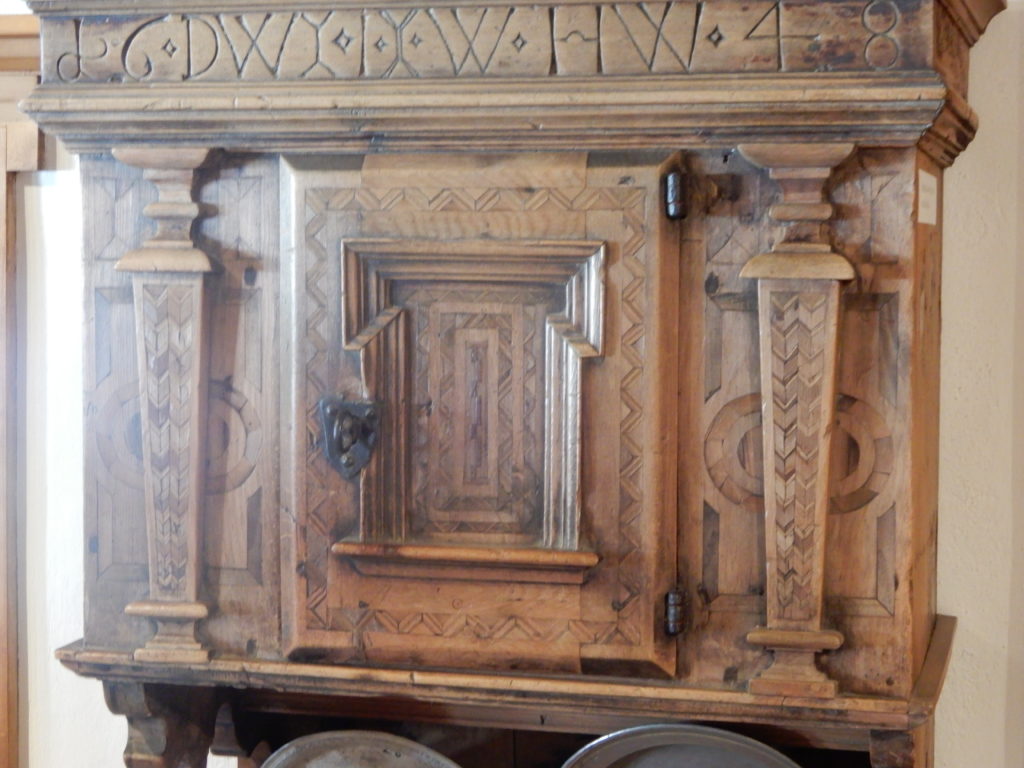
A cupboard with ornate hand woodcarving.
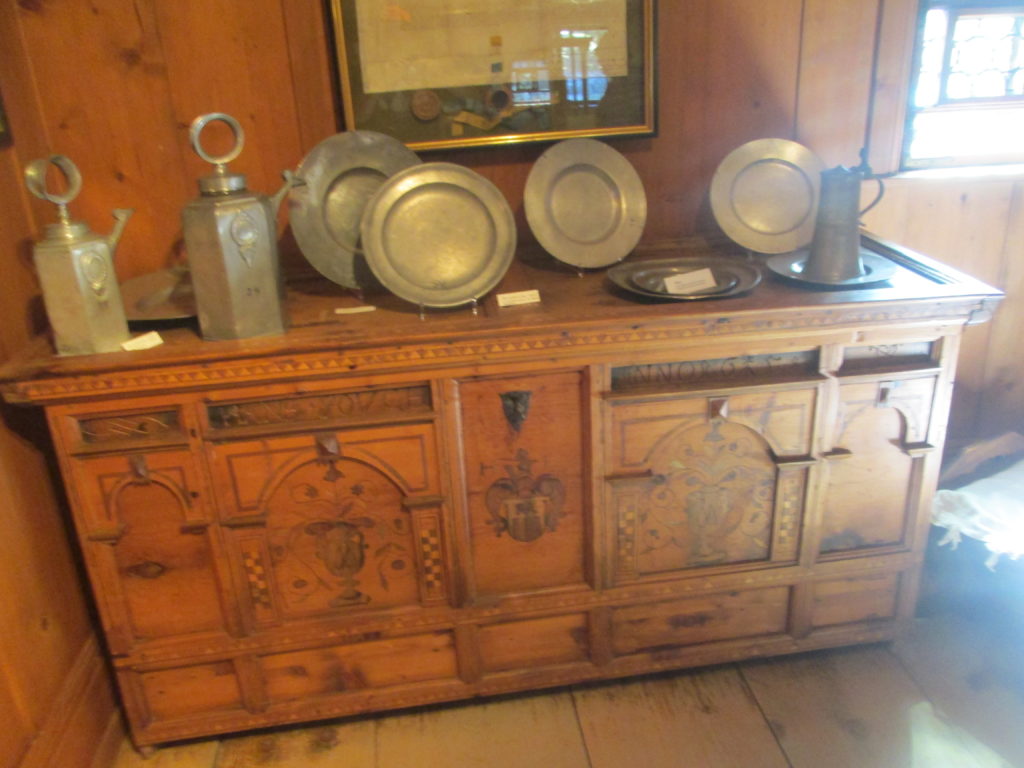
A wardrobe with ornate hand woodcarving.
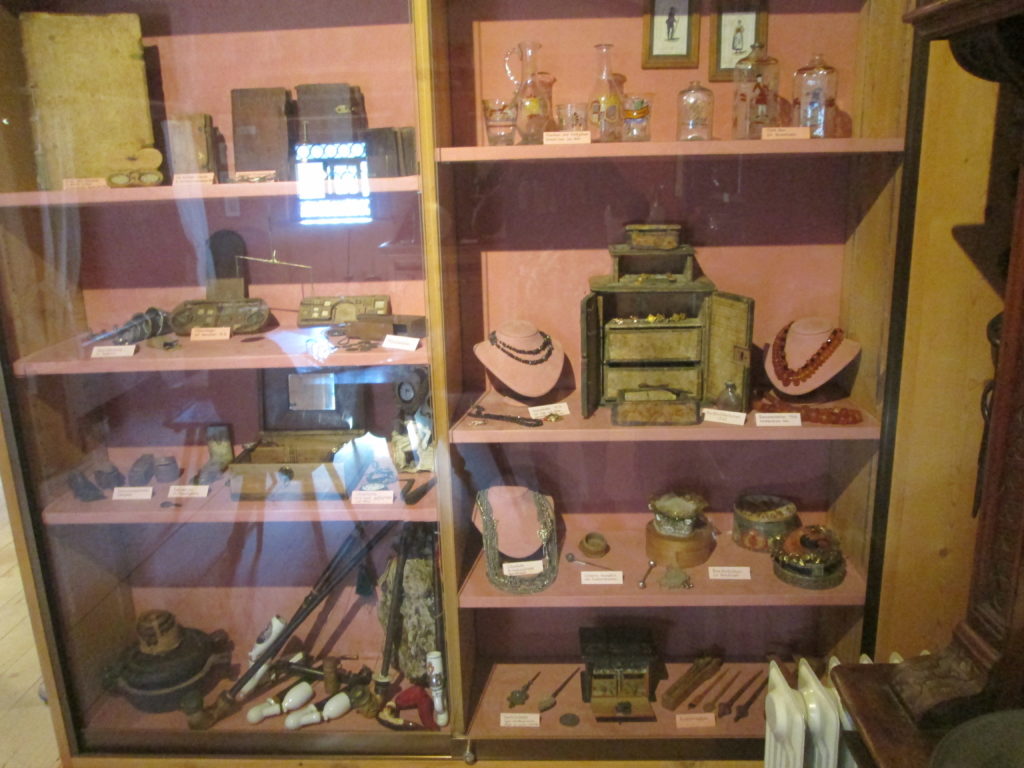
An open shelf displaying many small historical items.
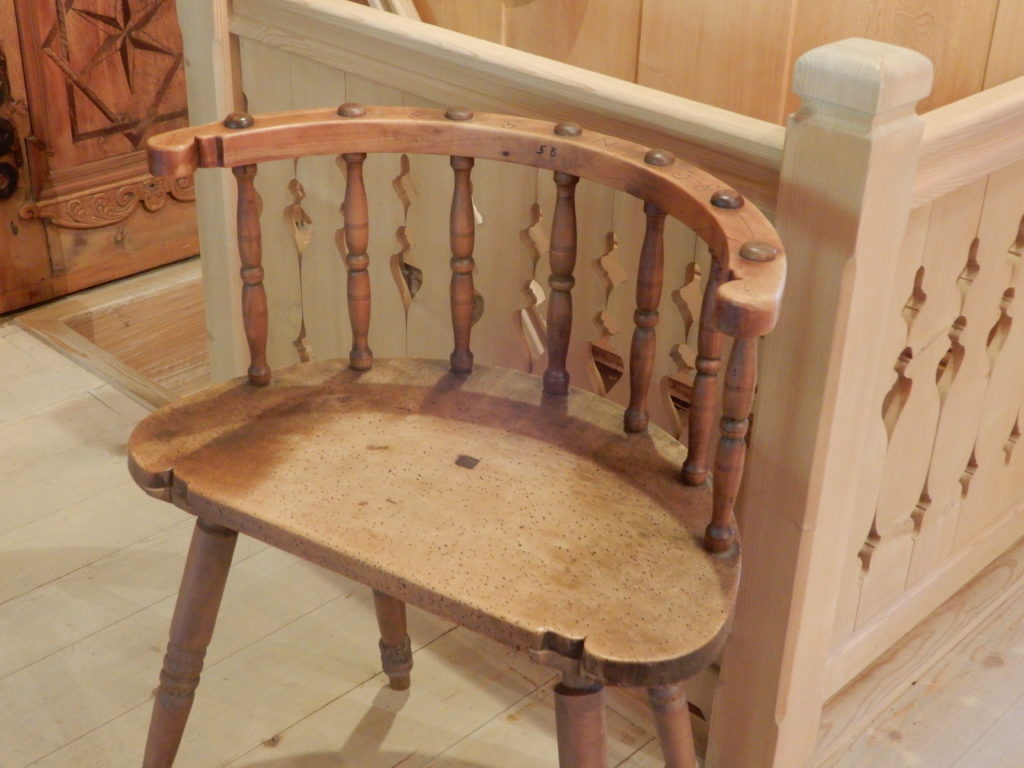
A handmade chair … beautifully crafted.
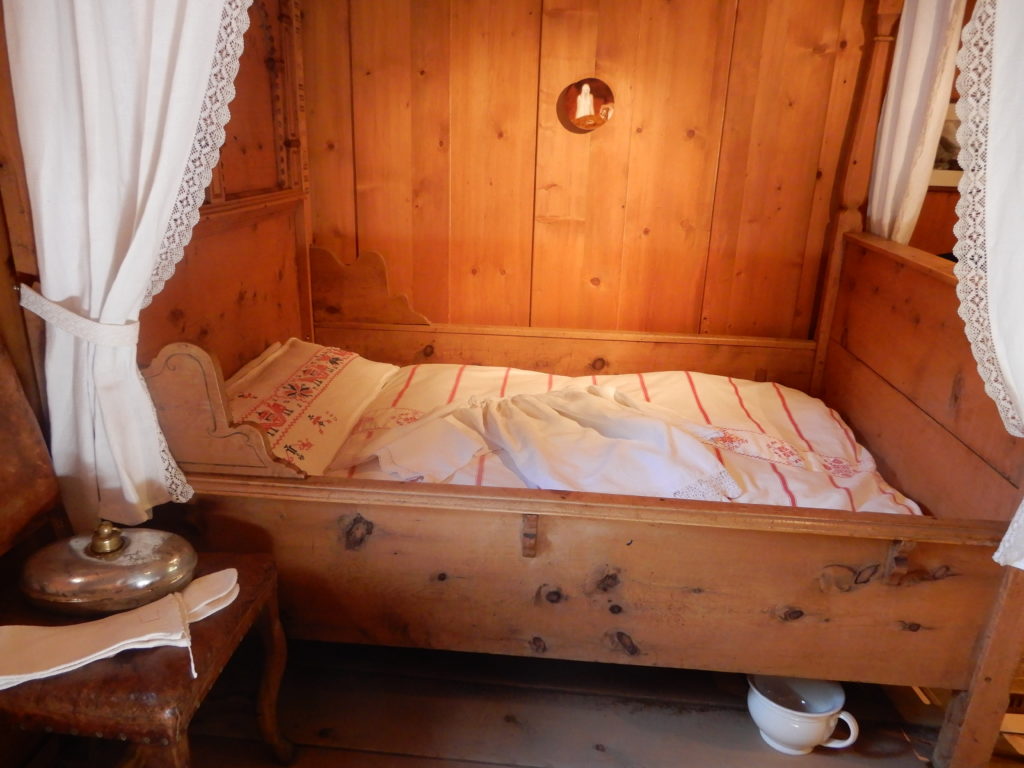
A small bed with a chamber pot under the bed. This means you do not have to go outside to wee at night in the dark. You just do it in the chamber pot and take it outside in the morning to empty it.
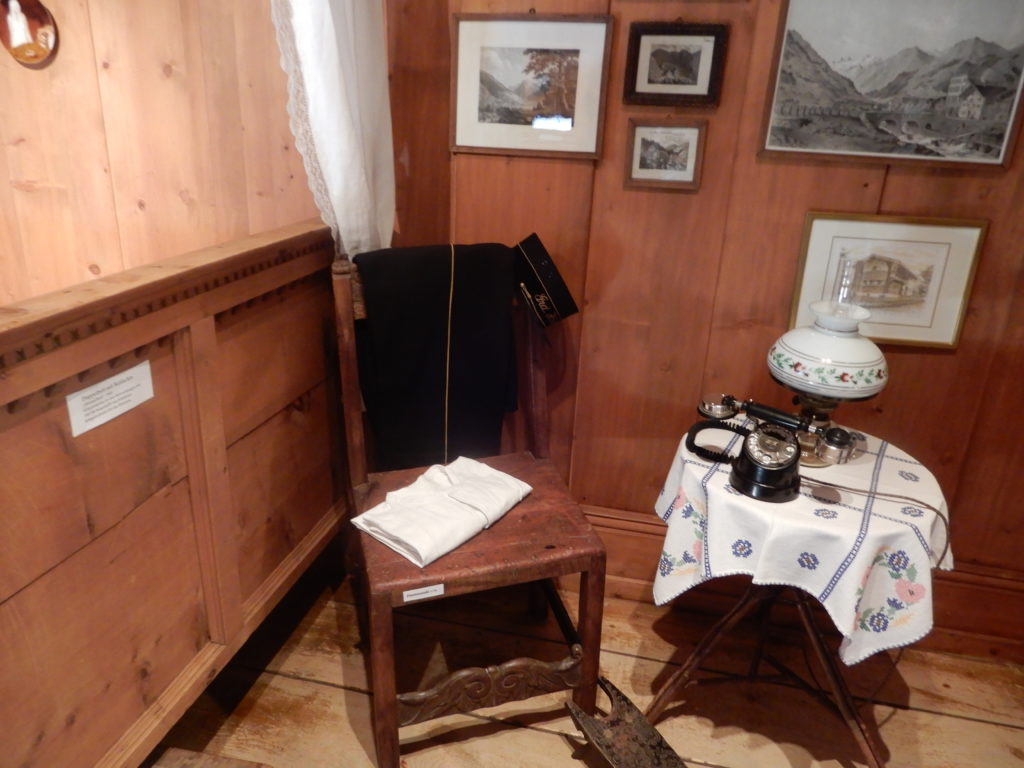
A small table with a small oil wick lamp and an early telephone. A handmade chair sits beside the table.
See these websites:
History of the telephone – Wikipedia
http://oldtelephones.com/the-history/
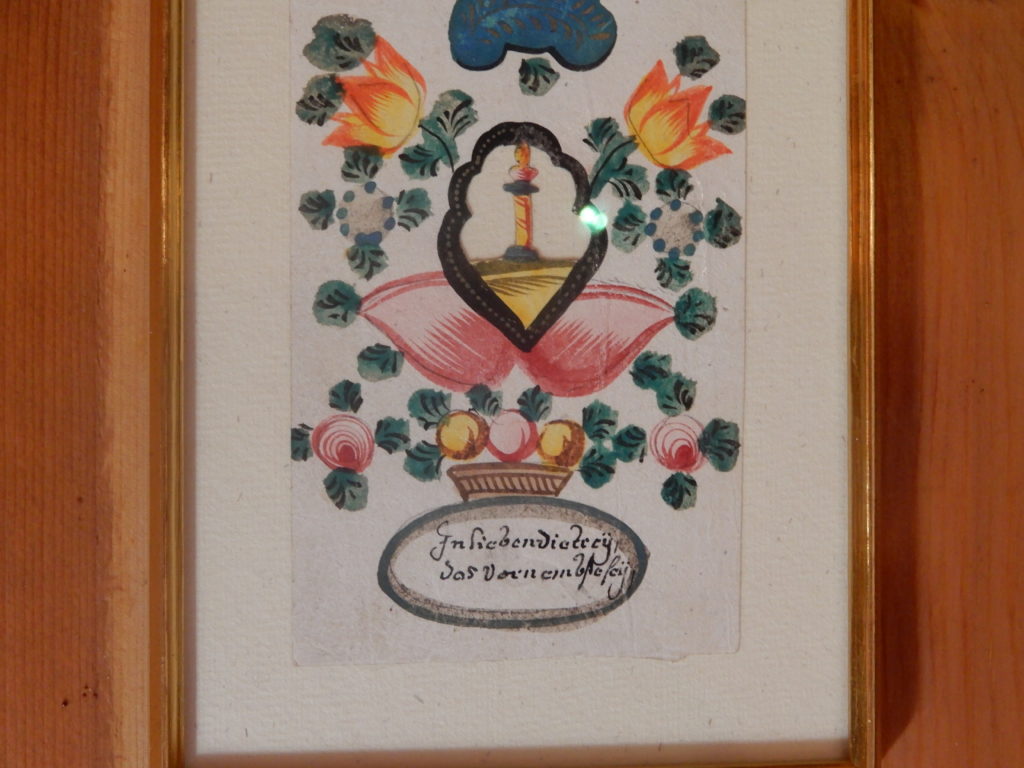
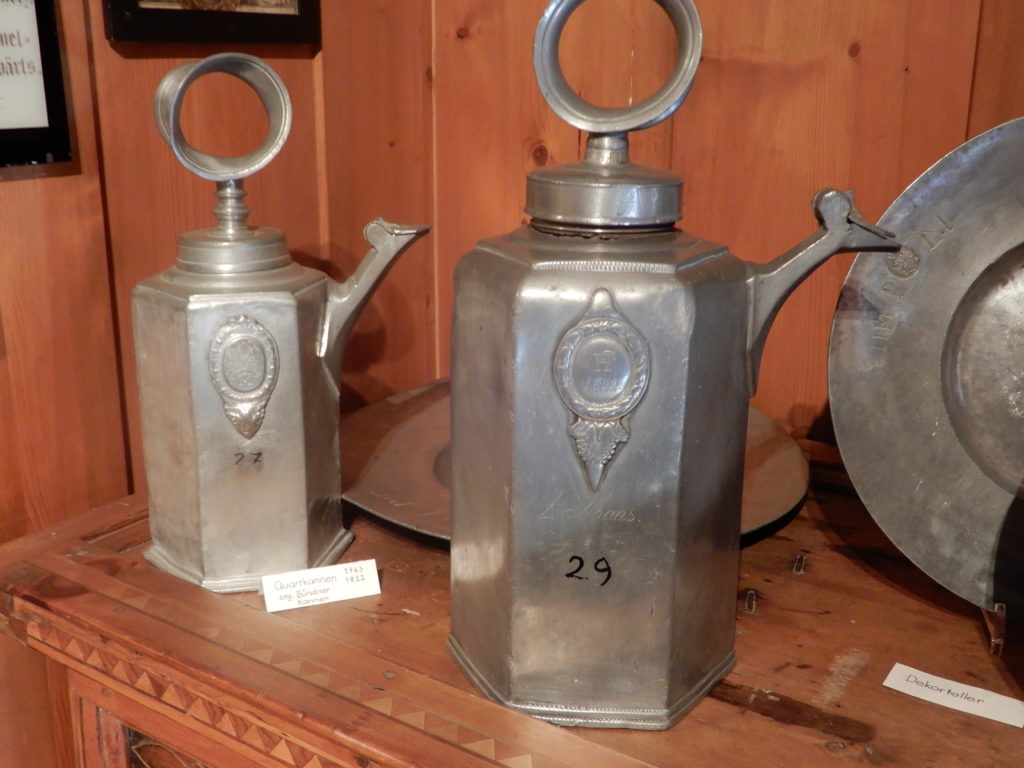
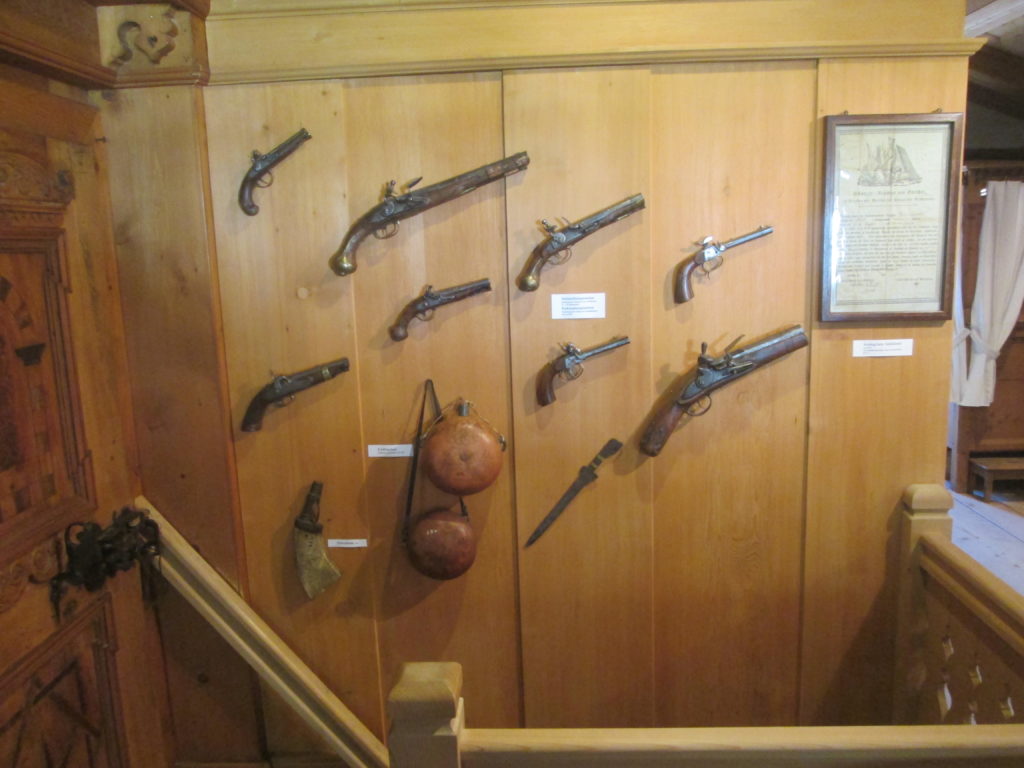
Wall of guns / pistols used in earlier years. There is one that isn’t a pistol but is a small bag for carting gunpowder. When a shot was fired, the pistol would need to be reloaded with a lead bullet and some gunpowder. The trigger fired a hammer which caused a spark to light the gunpowder and fire the bullet at the target.
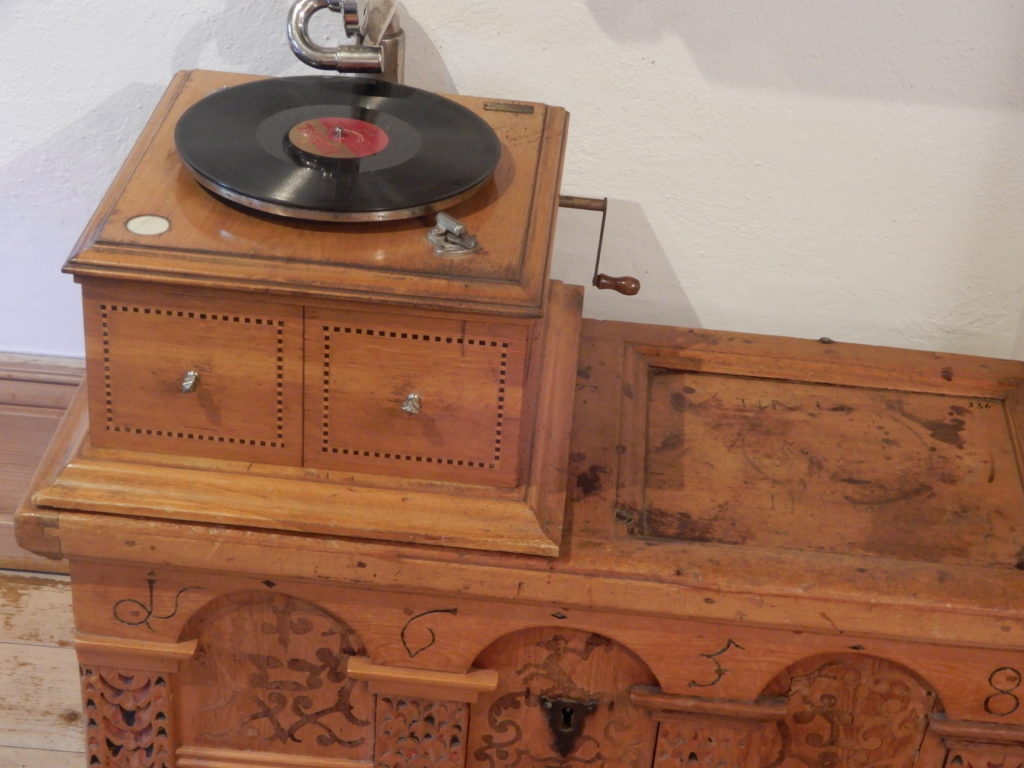
An old hand-turned gramophone. The handle was turned a number of times which wound a spring to turn the gramophone plate or turntable. On the turntable was placed a record with fine grooves of recorded music. Music was played when the gramophone head with a fine pin was carefully lowered on to the record.
Read this website: How the Wind-up Gramophone or Phonograph Worked
Here are some pieces of the writing relevant to the gramophone in the museum:
- Wind up the motor using the handle on the right side of the cabinet. The clockwork motor could play eight to ten songs before needing to be rewound.
- Place the record on the turntable and place the needle (it wasn’t called a stylus then) in the take-up groove at the outer edge of the record.
- Operate the start lever to play the record.
Because of the high turntable speed and the coarse groove pitch, a ten-inch record only lasted two and a half minutes per side. This is why the popular songs of the era were never longer than two and a half minutes. If it wouldn’t fit on a record, it wouldn’t sell.
How Did it Work?
A hundred years ago, microphones, amplifiers, and loudspeakers hadn’t been invented, or at least they were still in the laboratory stage, so music had to be recorded and played back acoustically. A record’s groove was not perfectly smooth, but carried the imprint of the original sound wave in the form of a microscopic, side-to-side meandering in the groove. The needle followed this meandering more or less faithfully, and the resulting vibration was transferred by mechanical coupling to a small circular diaphragm mounted vertically in the head of the tone arm. The tone arm was hollow and made of brass. It carried the sound down below the turntable to a flared plywood horn that had its mouth just behind the top doors mentioned earlier. The exponential horn is often wrongly described as an acoustic amplifier. It is, in fact, an acoustic transformer, coupling the vibrational energy of the diaphragm more efficiently with the surrounding air. (Trumpets and trombones work exactly the same way.)
Slow, Slow, Quick, Quick
Another wonder of this old machine was that it could play about twenty minutes of music on a single wind-up, without ever slowing down. Then, suddenly, it would slow down and stop all in a few seconds. It managed this because in the heart of the clockwork motor was a beautiful little device called a centrifugal governor. This technology had actually been around for over a hundred years, controlling the speed of steam engines. The governor is driven at speed by the motor and is geared up. This causes the brass balls to swing outwards and upwards on their pivoted arms. The upwards movement lifts a collar, which is in turn coupled to (in the case of a steam engine) a steam valve, or (in our humble gramophone) a simple, felt friction pad. The net effect is the same: The faster it tries to go, the more it is held back, resulting in constant speed from fully wound to almost fully unwound.
Just a Few Facts
- The tone arm had to be heavy because, with no amplification, all the energy had to come directly from the needle in the groove.
- A needle lasted only for about six plays, then it was too blunt to follow the groove.
- Needles were graded loud, medium, or soft. They came in little metal boxes of 100.
- Before 78 rpm was standardised, records were made to play at a range of speeds. 76 and 80 were not uncommon. Some even played from the inside out.
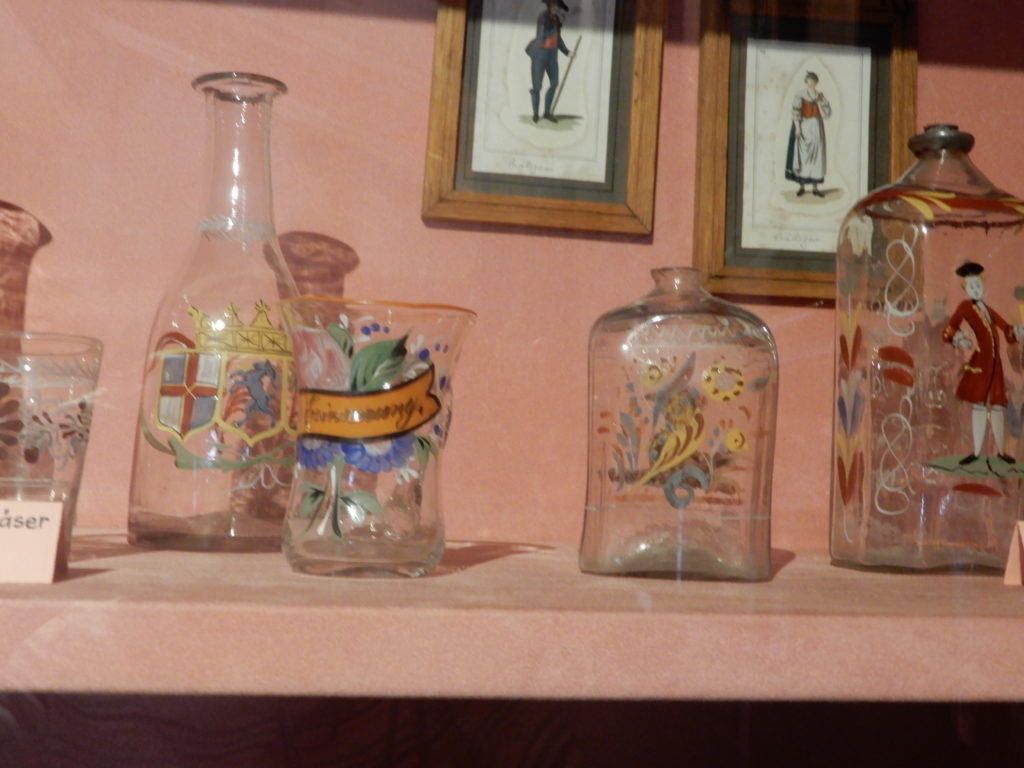
Some beautiful bottles and jars used for decorative purposes.
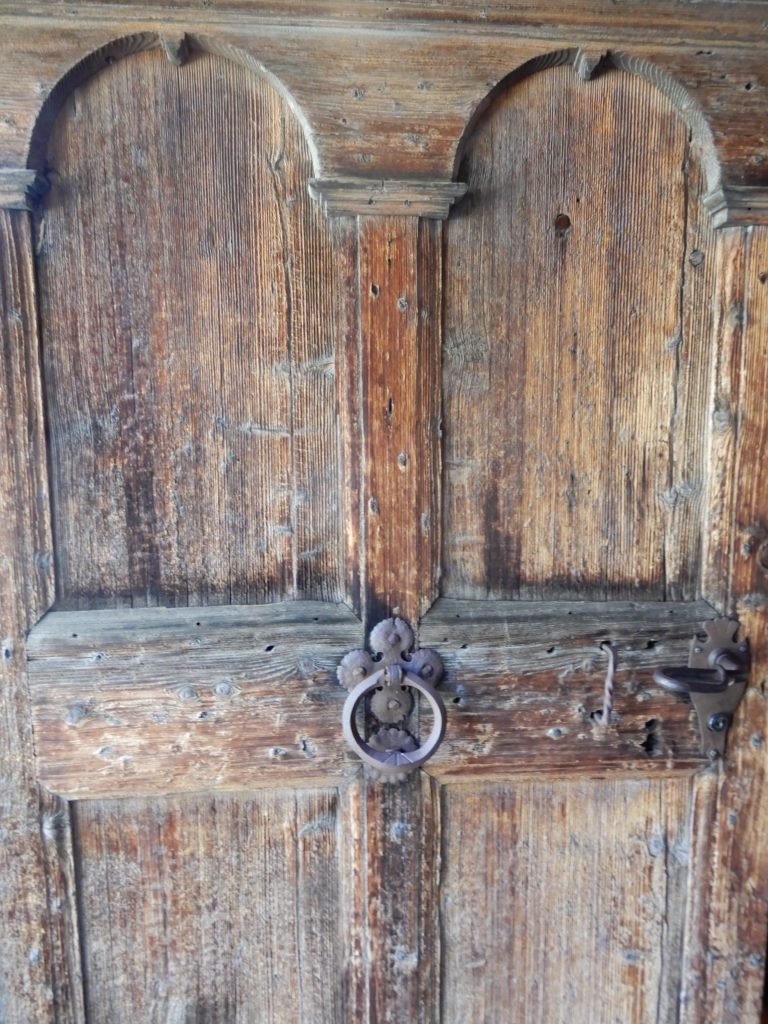
A beautiful hand-made door.
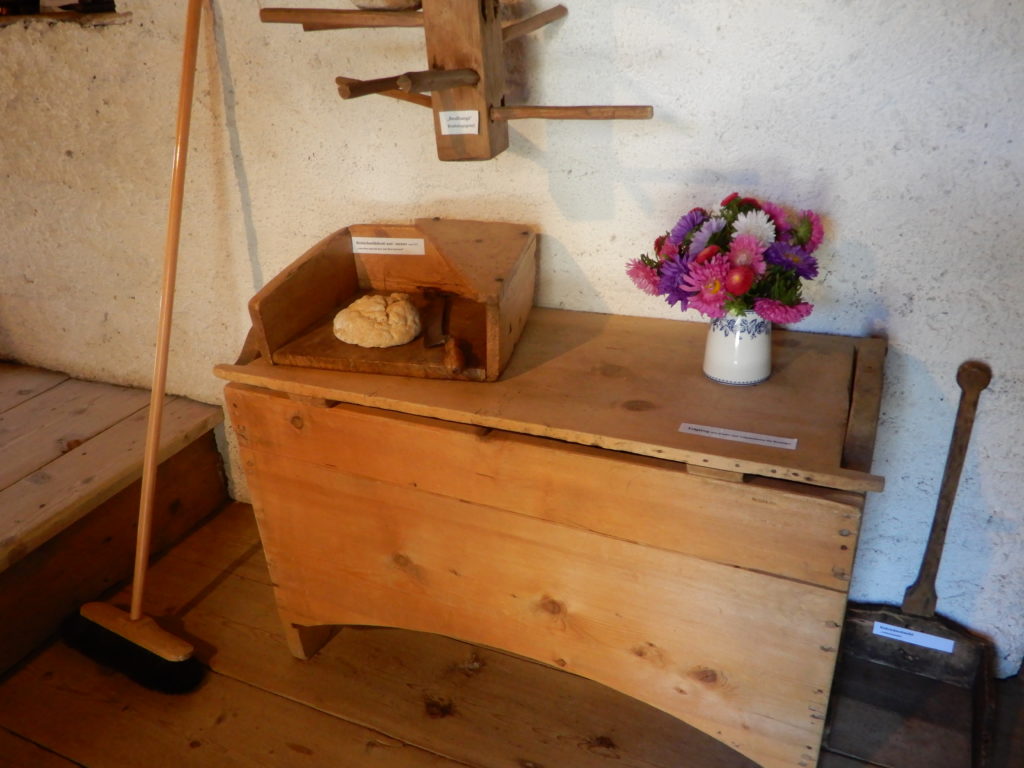
A beautiful hand-made cupboard for a vase of flowers etc.
________________________________________________________________________________________
DOWN STAIRS ON FLOOR 1: Floor 1 had a demonstration of old tools used in the 17th -19th century.
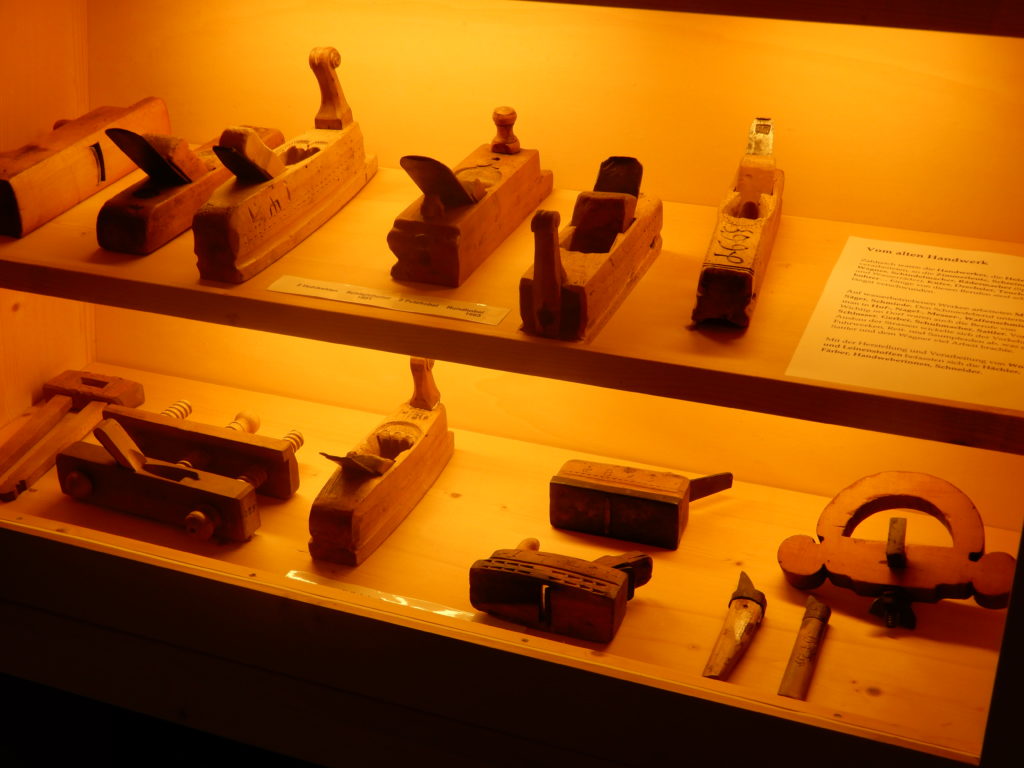
Old wooden planes.
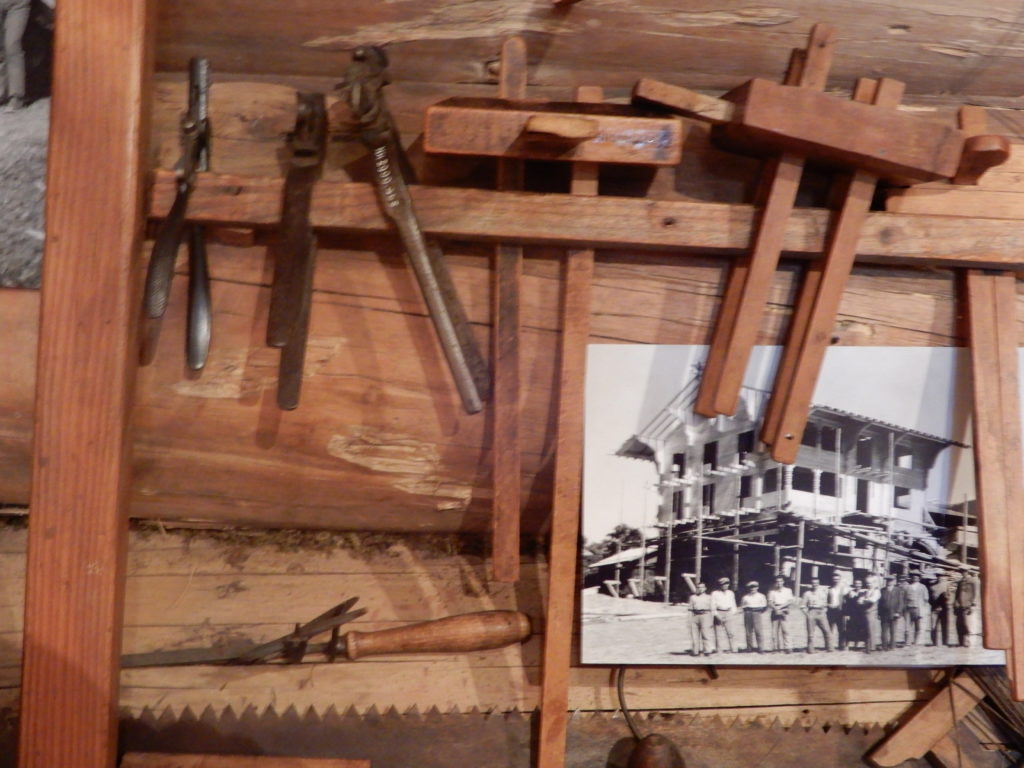
A photograph of a house being built by this team of keen builders.This would have been in the 19th century when photography was invented. Read the website: The History of Photography – Nicephore Niepce House Photo Museum
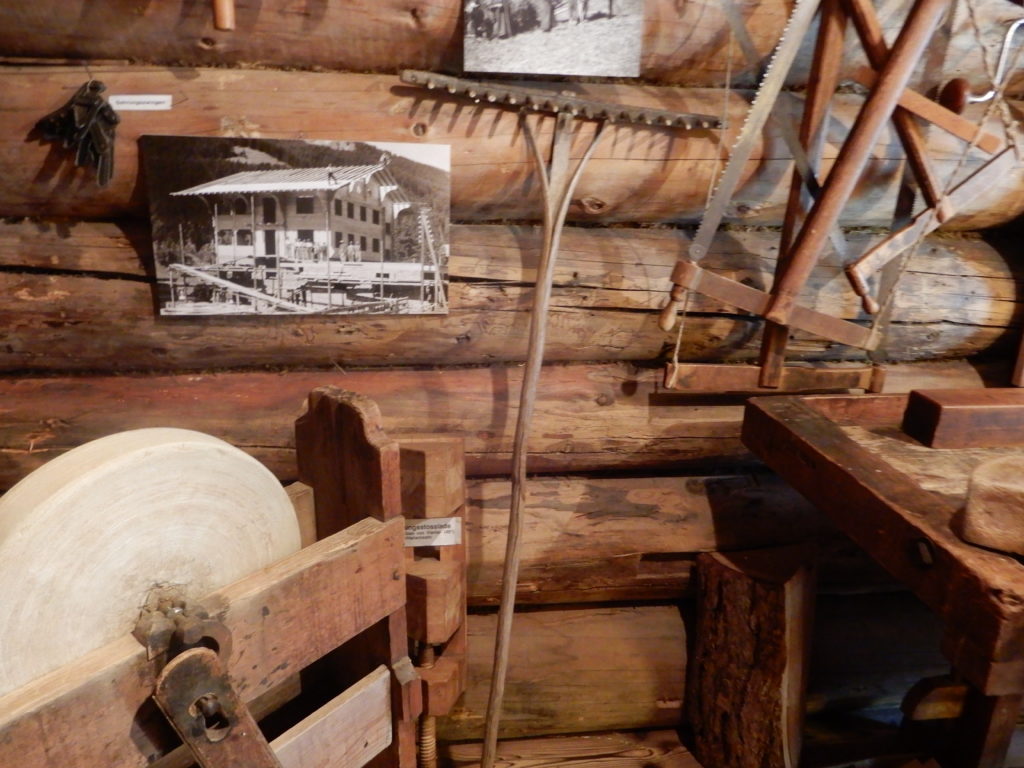
An old grinder for sharpening blades ….. hand turned, an old steel rake, and old saw. Again a photograph of a house being built.
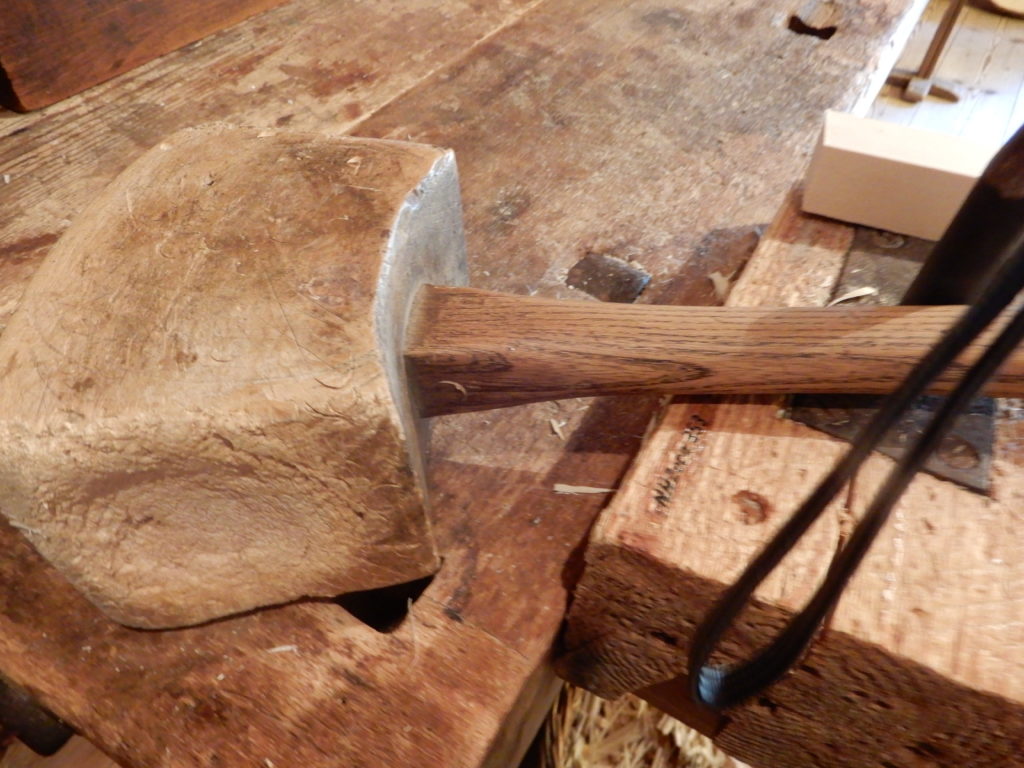
An old wooden headed mallet. Read the website:
Mallet – Wikipedia
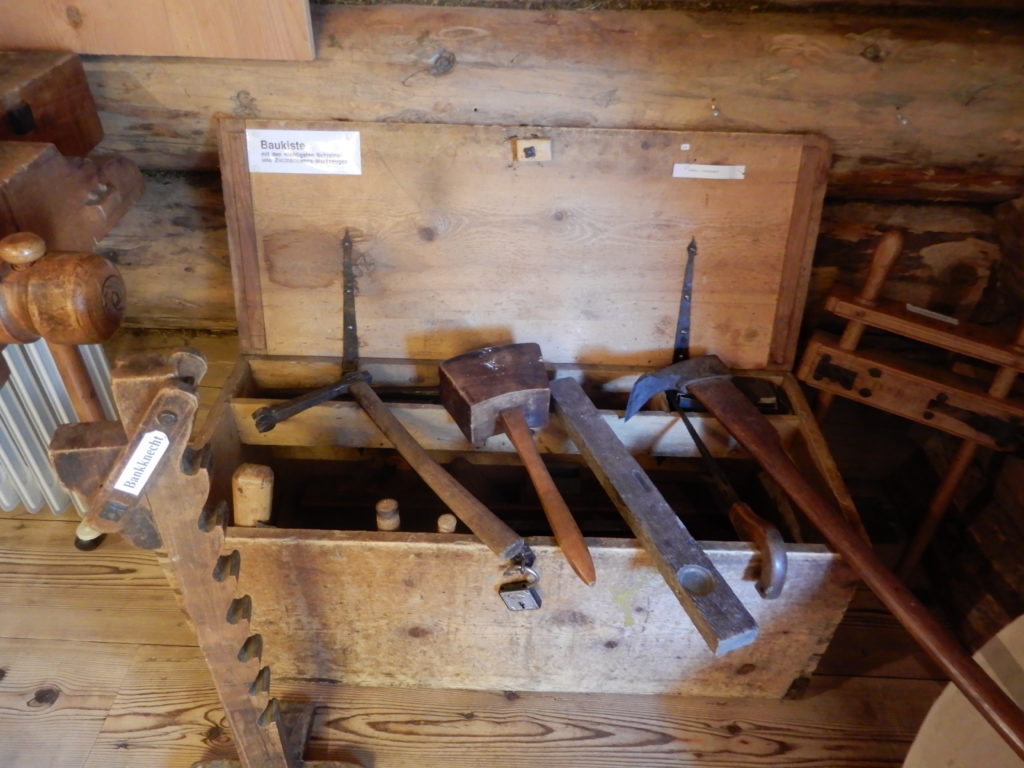
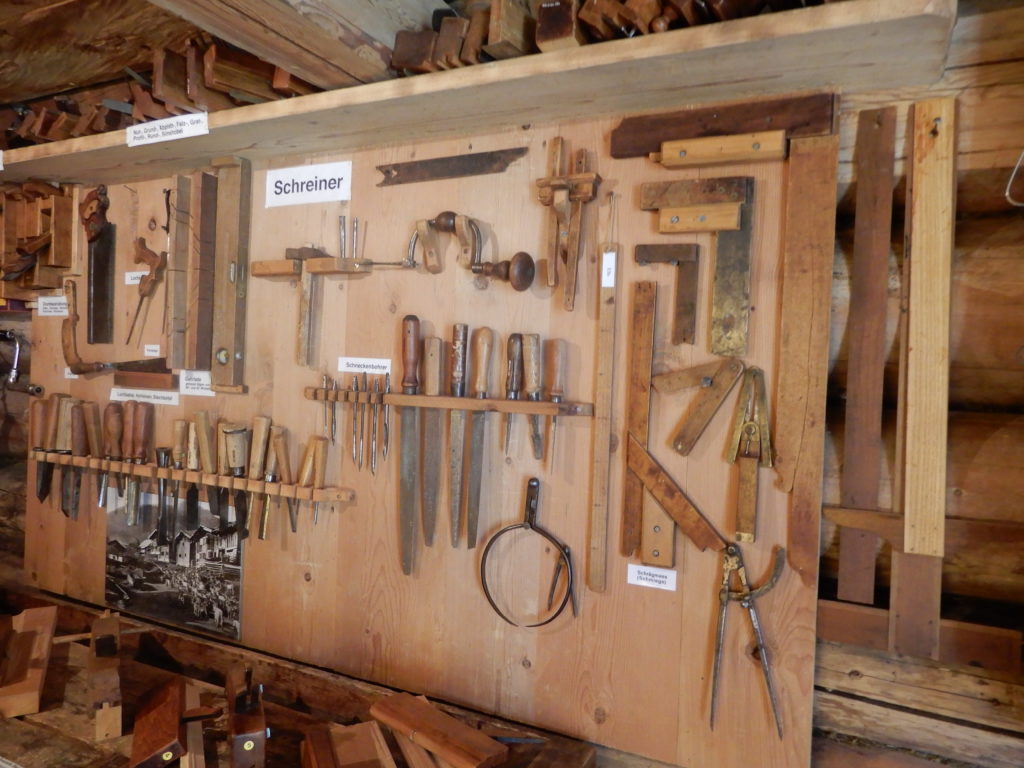
A big variety of many different tools from squares on the right side of the display to files then to chisels.
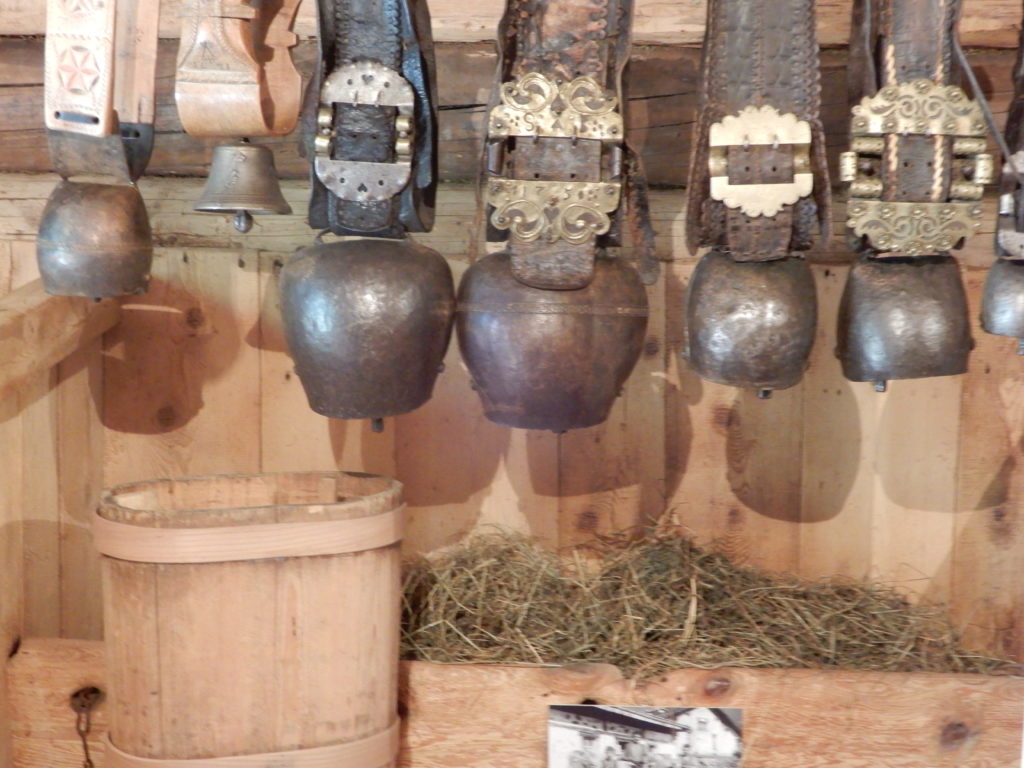
Cow bells are used extensively in Switzerland. Read the website:
Cowbell – Wikipedia A cow bell or cowbell is a bell worn by freely roaming animals made to scare off any predators. Although they are typically referred to as “cow bells” due to their extensive use with cattle, the bells are used on. The importance of the cow bell is highlighted in Swiss folklore, which reflects a period when a great Trychel, ..
The bell and clapper are commonly crafted from iron, bronze, brass, copper, or wood. The collar used to hold the bell is traditionally made with leather and wood fibers.
Most cow bells are made of thin, flat pieces of plated sheet metal. Plating causes the sheet metal to have a surface which can be decorated or left plain. The craftsmanship of cow bells varies by geographic location and culture. The ornaments on the cow bell and the collar are usually decorative although some cultures believe that certain ornaments provide or enhance magical protections such as the power to prevent or cure fever and other illnesses.[citation needed] The cow bell is used to keep track of grazing animal herds such as goats, reindeer, sheep and cows. They are mainly used in Europe, Mediterranean areas and Latin America, but are also used worldwide by those who practice transhumance, including nomadic pastoral tribes in Africa and Asia.[2][3]
Different bells can have specific sounds to identify important characteristics of the animals, such as age, sex, and species. Some cultures have even developed names to differentiate between bells and their tones; for example, in Spanish “truco” refers to stud males, “esquila” to female goats or ewes, and “esquileta” for pregnant females and immature animals. Each of these bells possess unique sounds, shapes, and sizes.
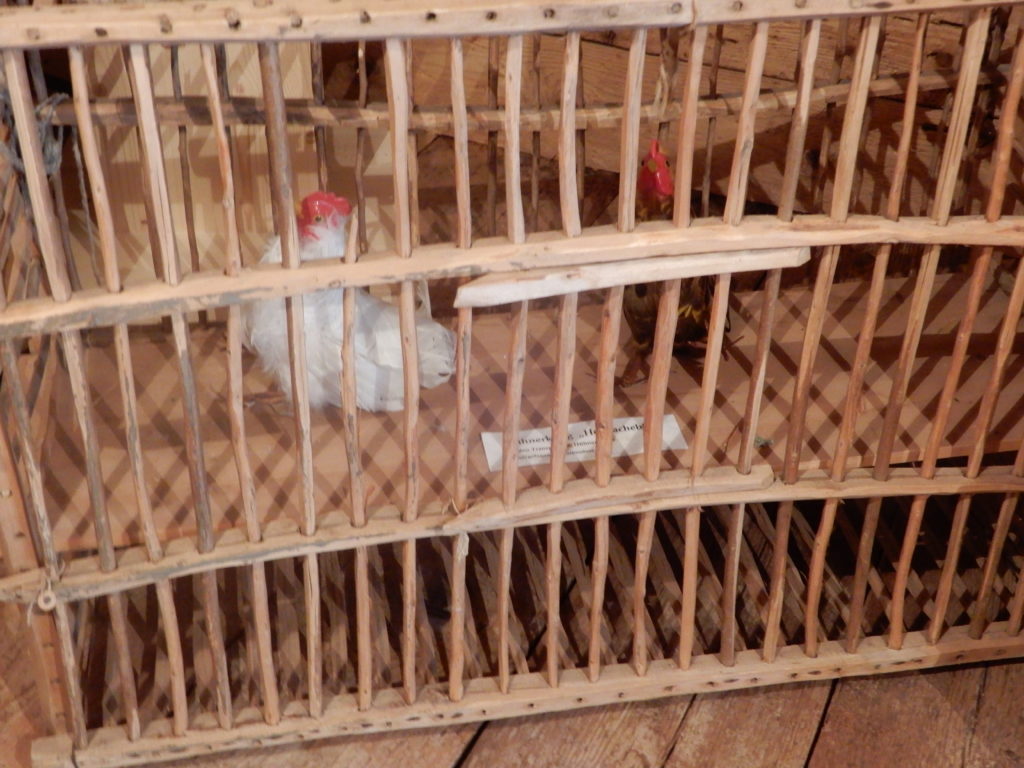
An old home-made hen coop ….. a bit small for a hen coop but users would get a few eggs per day if the hens were watered and fed.
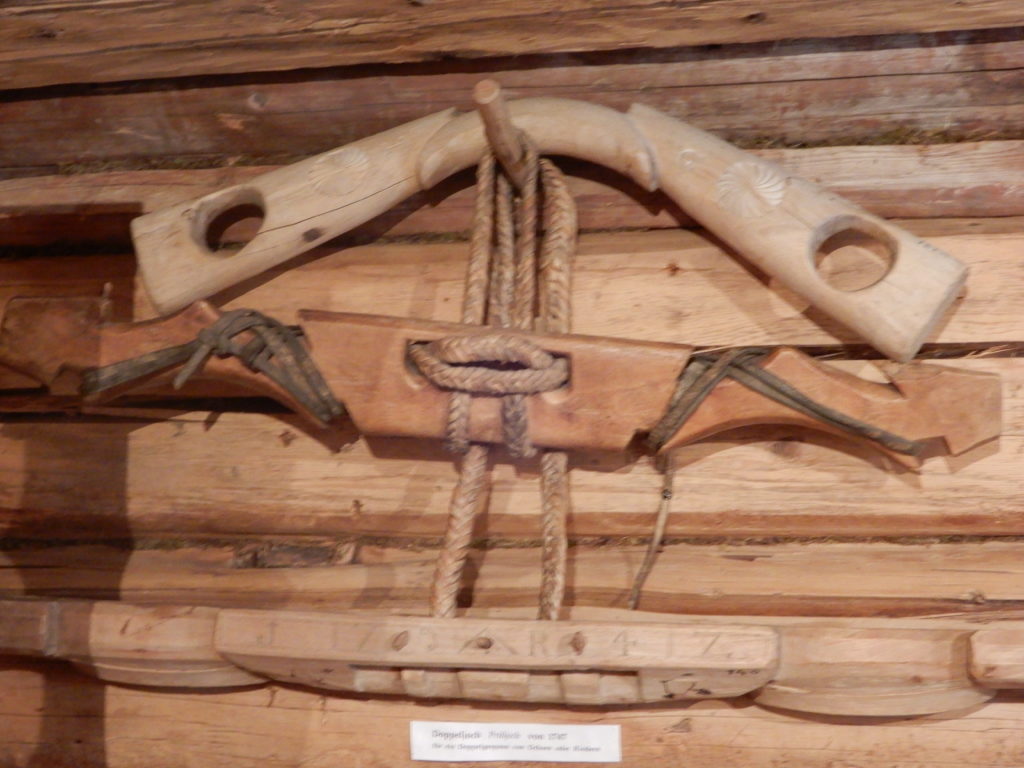
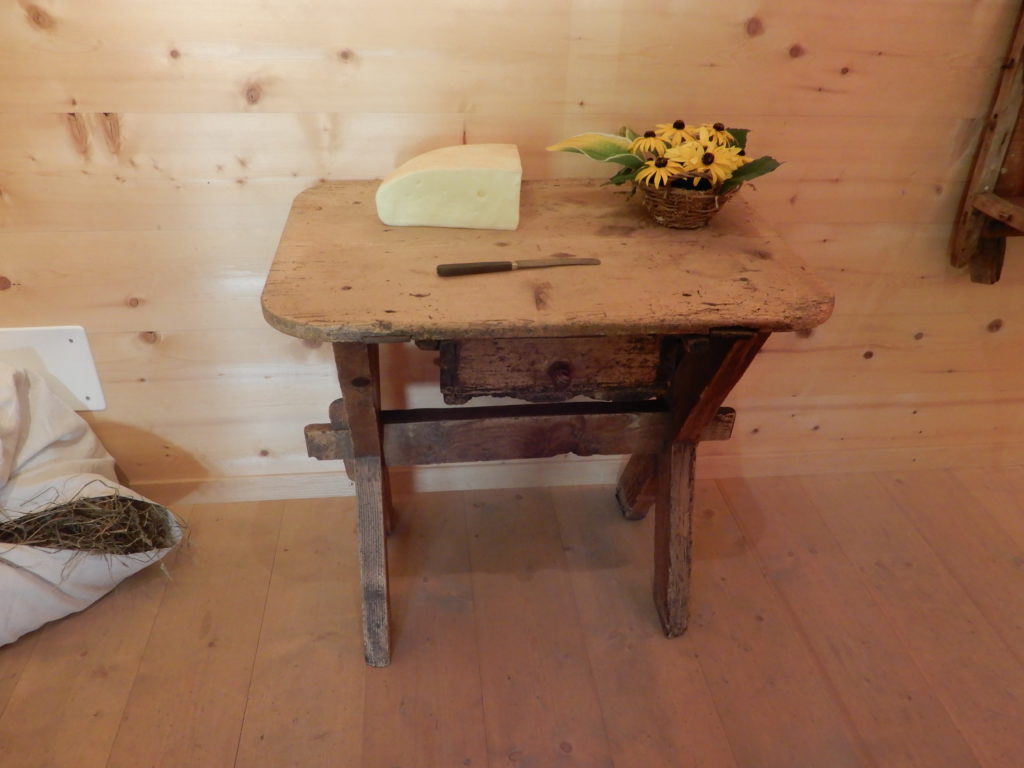
A small table to rest a few things on.
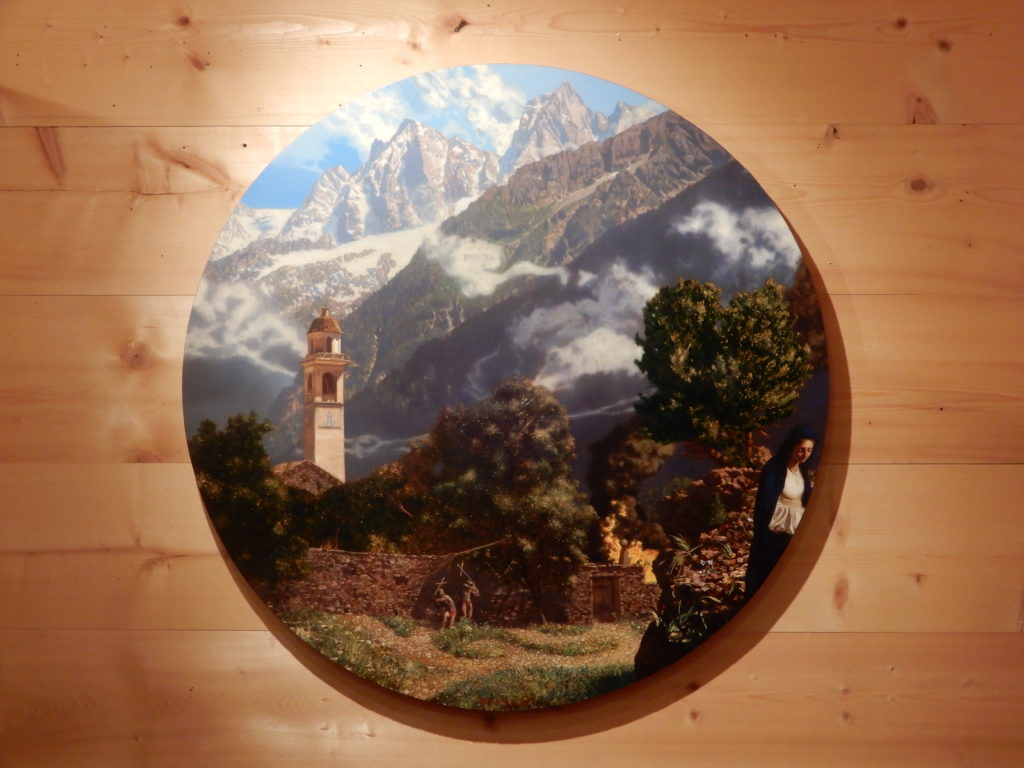
A painted image of surrounding mountains with a village surrounded by as stonewall. A bell tower of a church rises over the village.
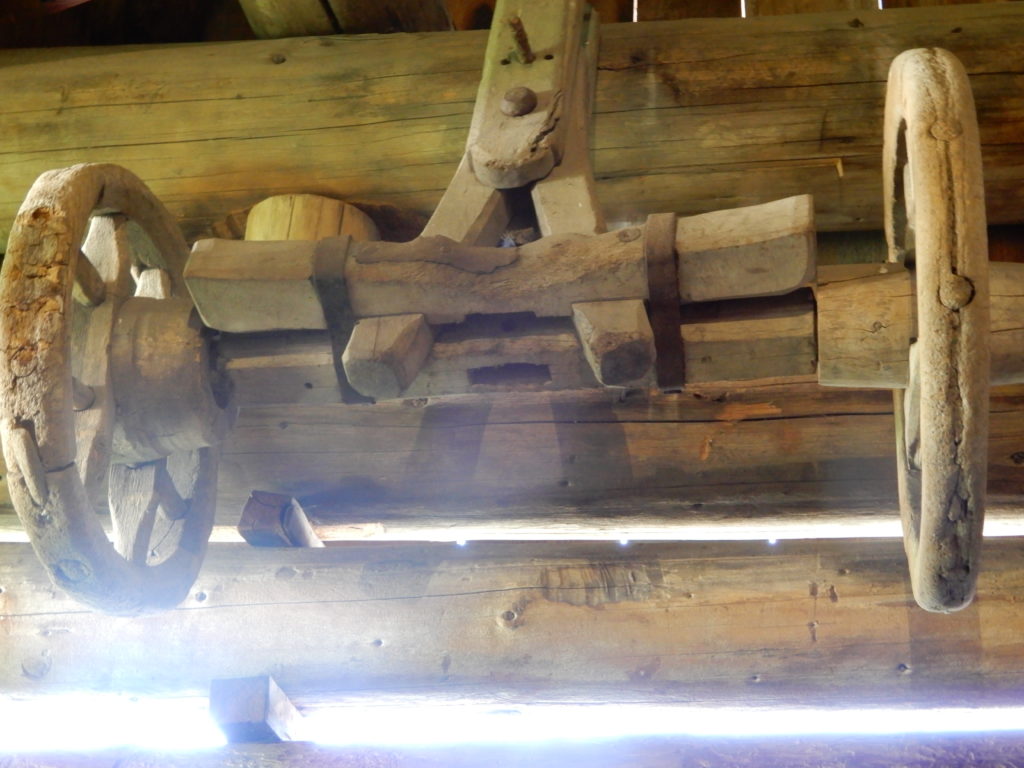
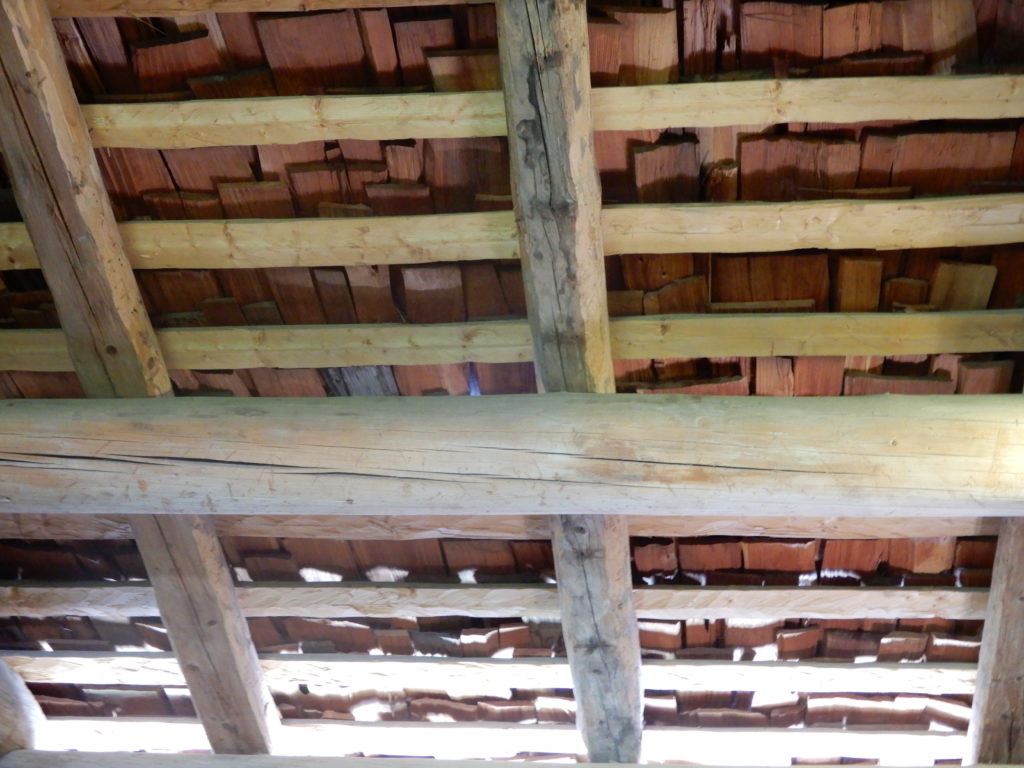
Up in the ceiling on Floor 3, round logs have been used to support the ceiling. Split wooden shingles have been used on the outside to seal the roof.
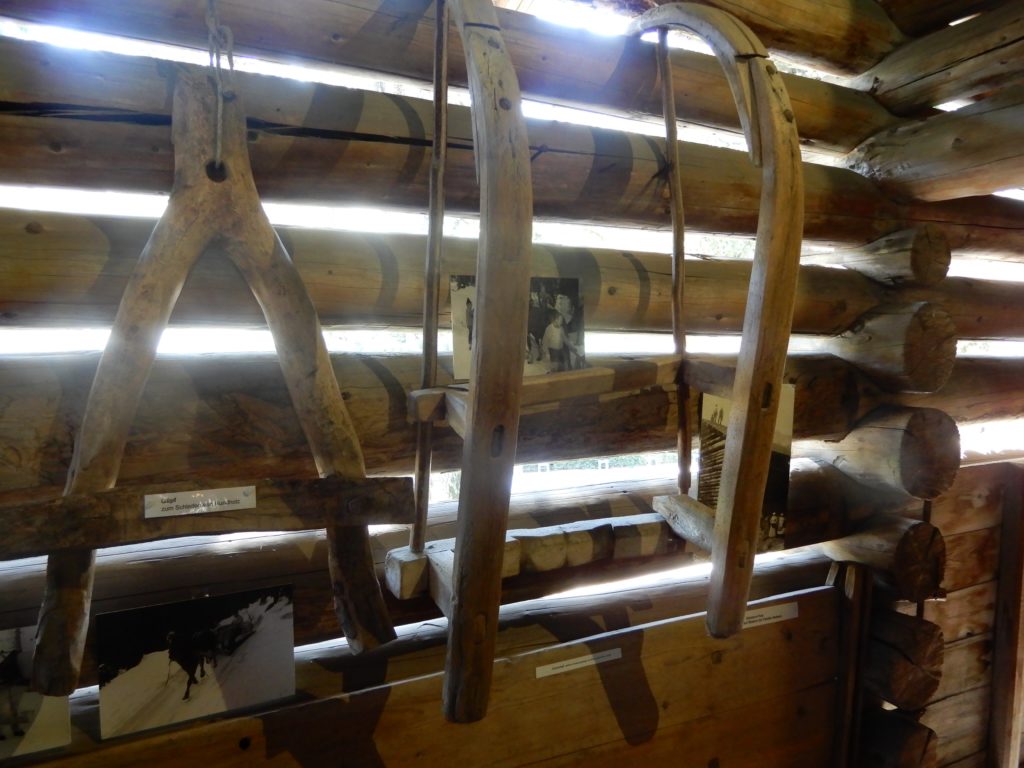
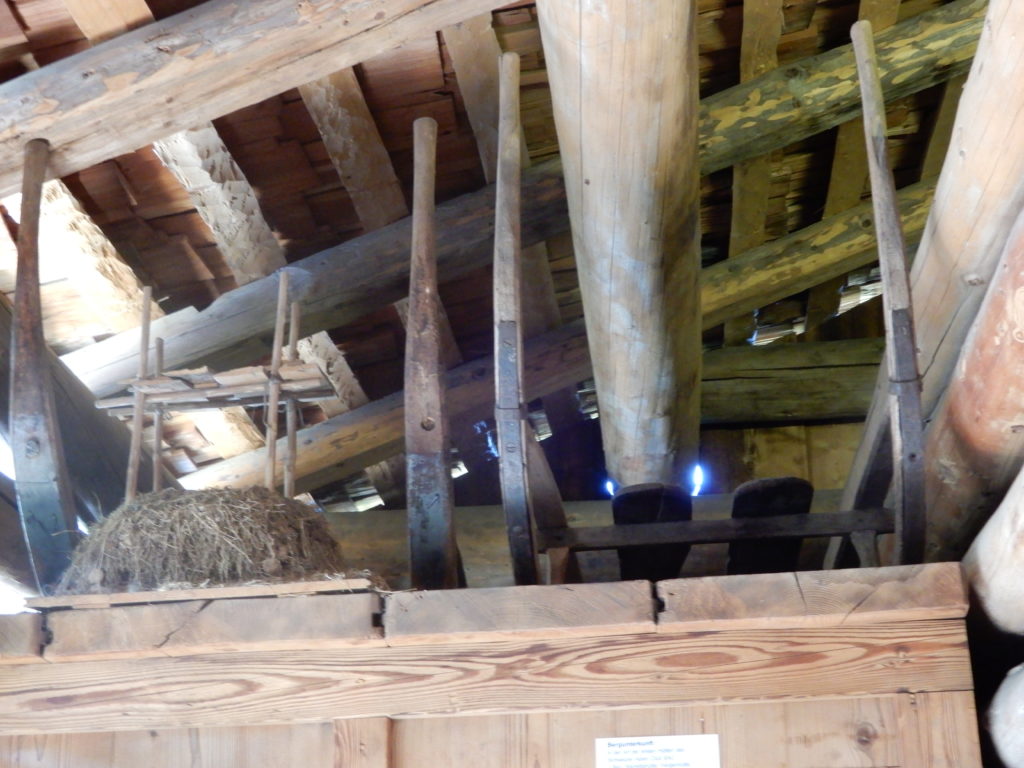
The photograph shows how up in the ceiling on Floor 3, round logs have been used to support the ceiling. Two small sleds with outside iron slides to prevent wear and tear on the timber sled.
The practical use of sleds is ancient and widespread. They were developed in areas with consistent winter snow cover, as vehicles to transport materials and/or people, far more efficiently than wheeled vehicles could in icy and snowy conditions. Early designs included hand-pulled sizes as well as larger dog, horse, or ox drawn versions.
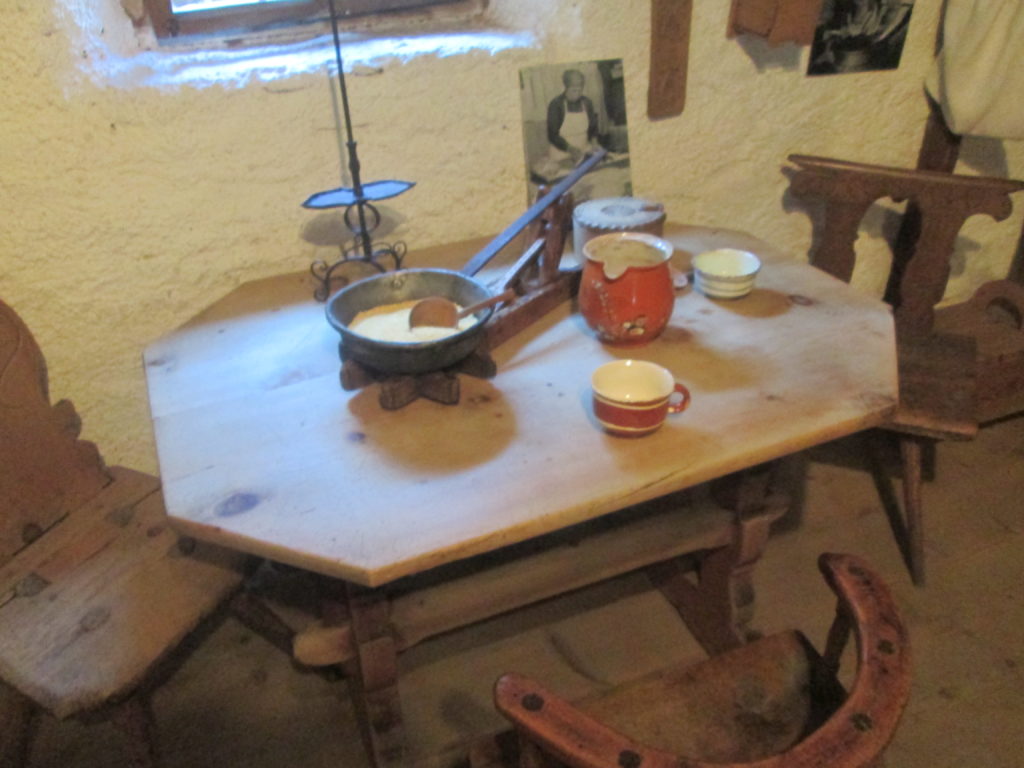
A meal table used by Klosters people in earlier times.
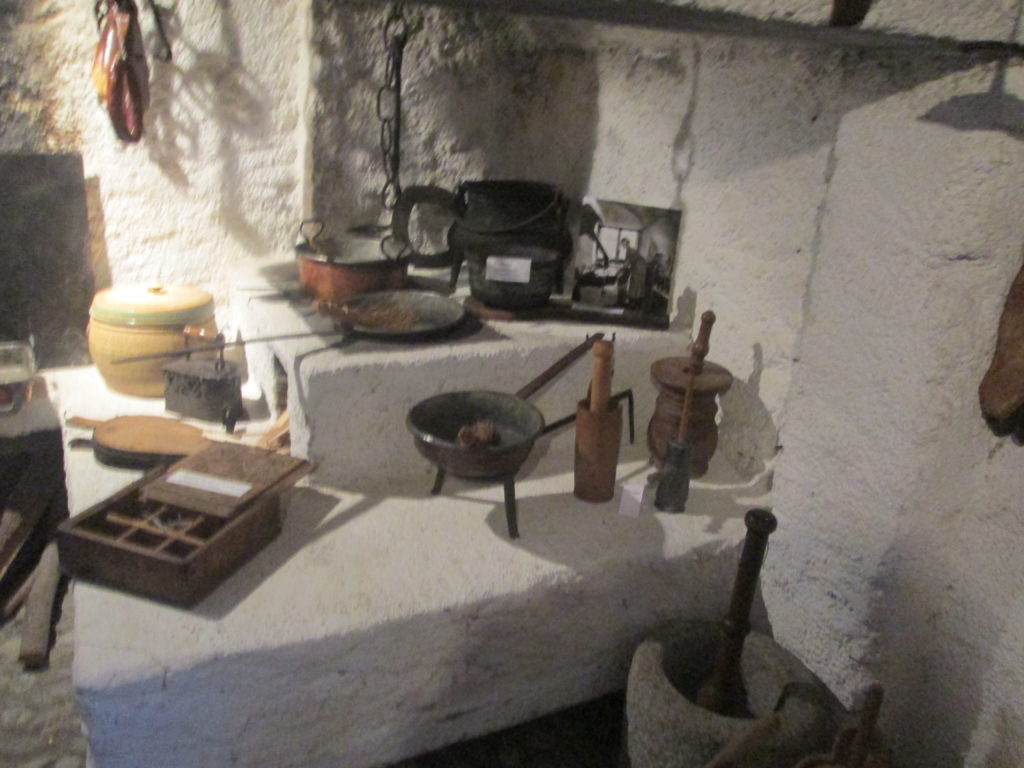
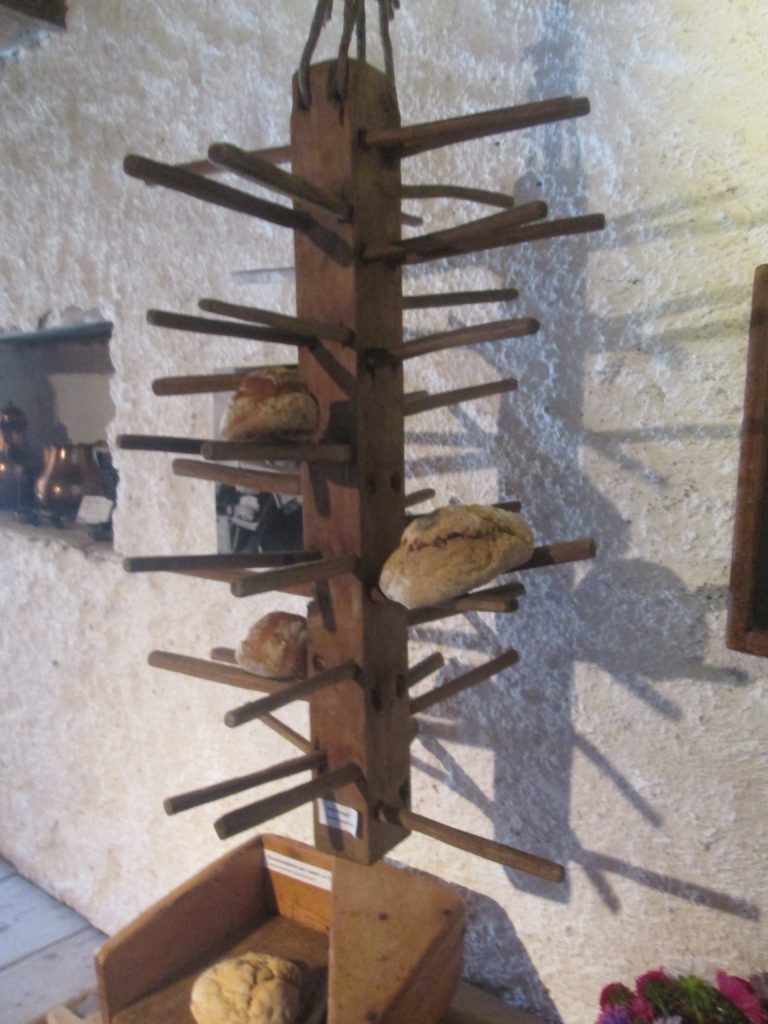
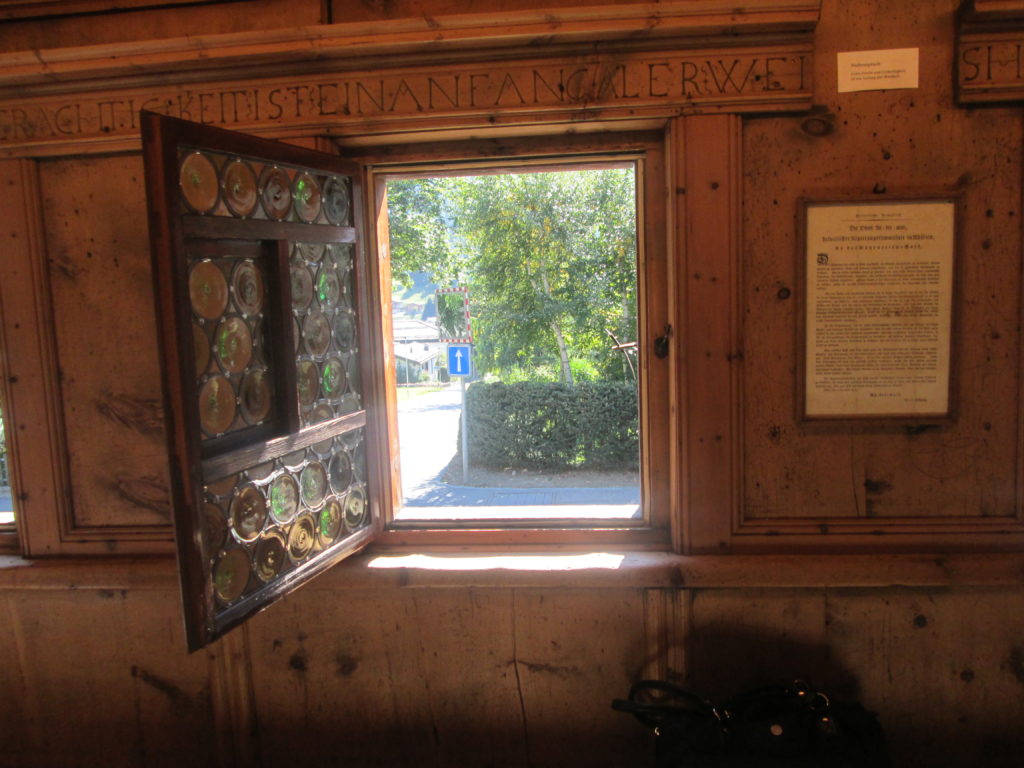
An open museum window signifies the end of an awesome time at Klosters Museum.
______________________________________________________________________________
